Horse Network
News, Sports, Lifestyle. Everyday.Simone Besutti: “It took 800 days for me to post the canter again” 20 Nov 2025, 10:16 am
I’ve ridden horses for most of my life. Often times, it’s been young horses, and because of that it’s become a habit to be aware of the details that are going on around me. Especially at horse shows, because you never know what can happen.
There are unexpected sounds—a motorbike passing by, or a flag snapping in the wind.
Even when you’ve been doing this professionally for many decades, like I have, and even when you are well-prepared with your horses, and take all the precautions, the unexpected can still occur.
On May 17, 2023, I was just a couple of months into a new job working for Nicki Shahinian-Simpson and Riffle Hitch Stables, where it was basically my role to prepare the FEI horses for the students. We were in Lexington, Kentucky, on a Wednesday at the horse show, and I’d already flatted two or three horses that morning. We’d also shown a few horses in the Young Horse classes and some others.
At about 10:30 a.m., I headed to the FEI warm-up ring, near the Rolex Arena, to ride one of the mares who would be competing a few hours later with one of our students. I’d been riding her for the last two or three months that I’d been hired, so I knew her fairly well by that point.
She was very sensitive, and I was used to taking extra time and precautions when working with her. For instance, she had a hard time with the travel involved to horse shows, and also with her girth, so we would always walk her and put the girth up very slowly, one hole at a time.
Her biggest thing was that when you rode her, you couldn’t get on using a mounting block, so our team had system for giving me a leg-up. At 10:51 a.m.—a time that will stay with me forever—I was getting ready to mount her, and we were along the edge of FEI schooling ring, near the bushes and the fence line.
The groom gave me a leg-up, the same way we did every day. But before I had even touched the saddle, or had a hold of the reins, the mare suddenly bucked, hard. She sent me flying into the air, and as I fell, I landed between the horse and the fence, and my right leg hit the middle fence board on the way down.
I think I very quickly went into shock at that point, so the details are still hazy. I have to rely on other people who were around me for what happened next.
I know I was there on the ground—I never passed out—so I was awake and aware. But I wasn’t feeling any pain, even though I really should have been.
I would learn later I’d suffered a compound, open pilon fracture of my right tibia, which basically exploded my ankle. The people around me could see that my bone had actually gone through my skin, and perforated through the double-leather of my riding boot.
Nicki was up there at the ring with me, and I was hugging her legs and screaming. They told me after they could hear me screaming across the warm-up to the other side of the horse show. It was strange, though, because I wasn’t screaming in pain.
The doctors told me later that with a major injury like mine, the body often shuts your pain sensors down immediately, so you don’t feel the injury. Although they had called the ambulance right away, it was late, so I ended up being down on the ground in the FEI warm-up area for almost 40 minutes.
Finally, I heard the sound of the ambulance sirens, and the EMTS arrived to take me to the University of Kentucky’s UK ER. They were immediately concerned about the possibility of infection in my leg, given how long I’d been down on the sand.
I still wasn’t feeling pain when we got to the ER, and I was angry and confused in the hospital, when the medical staff began to cut off my clothing. I saw this huge pair of scissors, and I realized they were cutting off a brand-new pair of breeches, and my Parlanti boots.
I was almost more upset about that than the actual injury at the time, because I still wasn’t grasping how serious it really was. But it was bad. Two years later, the people who know me and were there tell me not to look at the pictures that were taken of my leg in the ER.
They say I don’t want to see it, even now, so I haven’t looked.
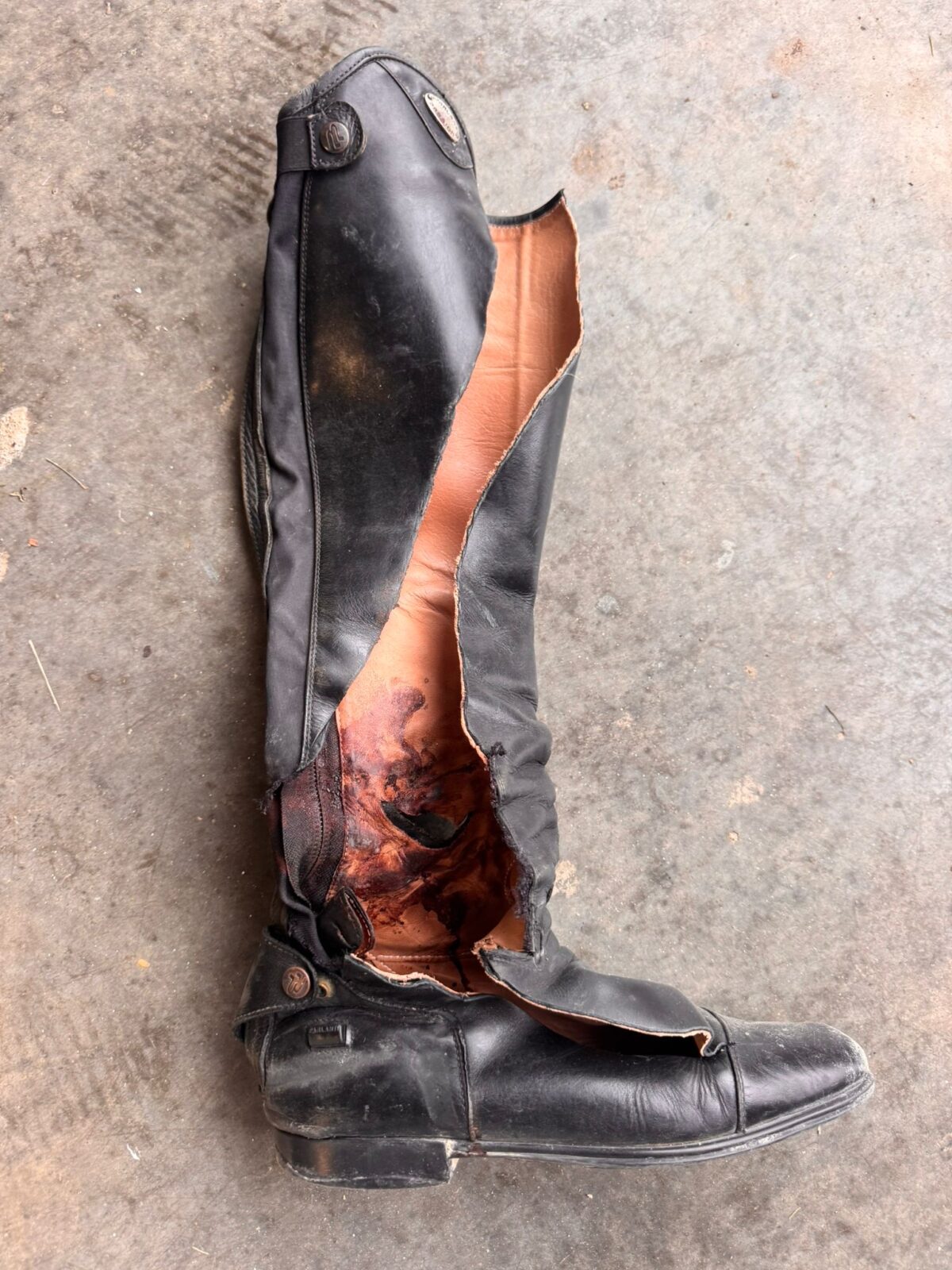
The ER doctors must have checked to make sure I hadn’t injured anything else in my body, and after that, they moved me to the Intensive Care Unit.
As a rider, I’ve fallen off many times in my career, and I’ve had to go to the hospital for a couple of them. Once, I had to have a surgery on my right humerus bone after a fall. But as the day wore on, I was realizing those other times were nothing like this.
The doctors who treated me were kind, competent, and accommodating. They were smiling, and trying to be positive, but I could feel there was something in the air.
The next four days in Intensive Care were a blur. There was no question that I needed surgery, but I was totally confined to my bed and on heavy pain and antibiotic medications while the doctors were deciding how to proceed. I couldn’t get up to use the restroom. It was just a very hard and frightening time.
When I was at last able to have surgery, they put an external fixator on my leg to stabilize my break. That’s a device that attaches to the bones inside your leg with pins and wires, but it is connected to a frame that is built around the leg on the outside.
When I woke up, I remember it was very strange to see my leg in that. But what I really remember feeling at the time was anger.
For someone like me, who rides and trains for a living, I need my legs to move—to ride horses and walk courses with students. It’s how I earn my living, so I was immediately very concerned. Mostly, I worried about who would take care of my mother in Northern Italy.
They told me later that when I was on the ground, right after my injury, one of the things I was yelling was, “Who is going to help my mother? Who is going to help my family now?”
I don’t remember doing it, but it makes sense. I’m alone over here, and my family—even though they are far away—is everything to me. I had been helping to support my mother and sister from over here, and I was immediately fearful about what this injury would mean for them, too.
Thankfully, they never knew how bad it really was. Even today, my family probably only knows 50 percent of what really happened to me.
I called them once before my first surgery, because I knew I was going to be under anesthesia. I minimized the surgery I was having, and told them it was just a regular fracture, but that because they were putting me under, I was calling them “just in case.”
That first external fixator surgery gave me a bit of mobility, thankfully, and with the help of a roller, I could now get down from the bed, and use the restroom, and wash my face. I hadn’t been able to do any of those things for more than four days.
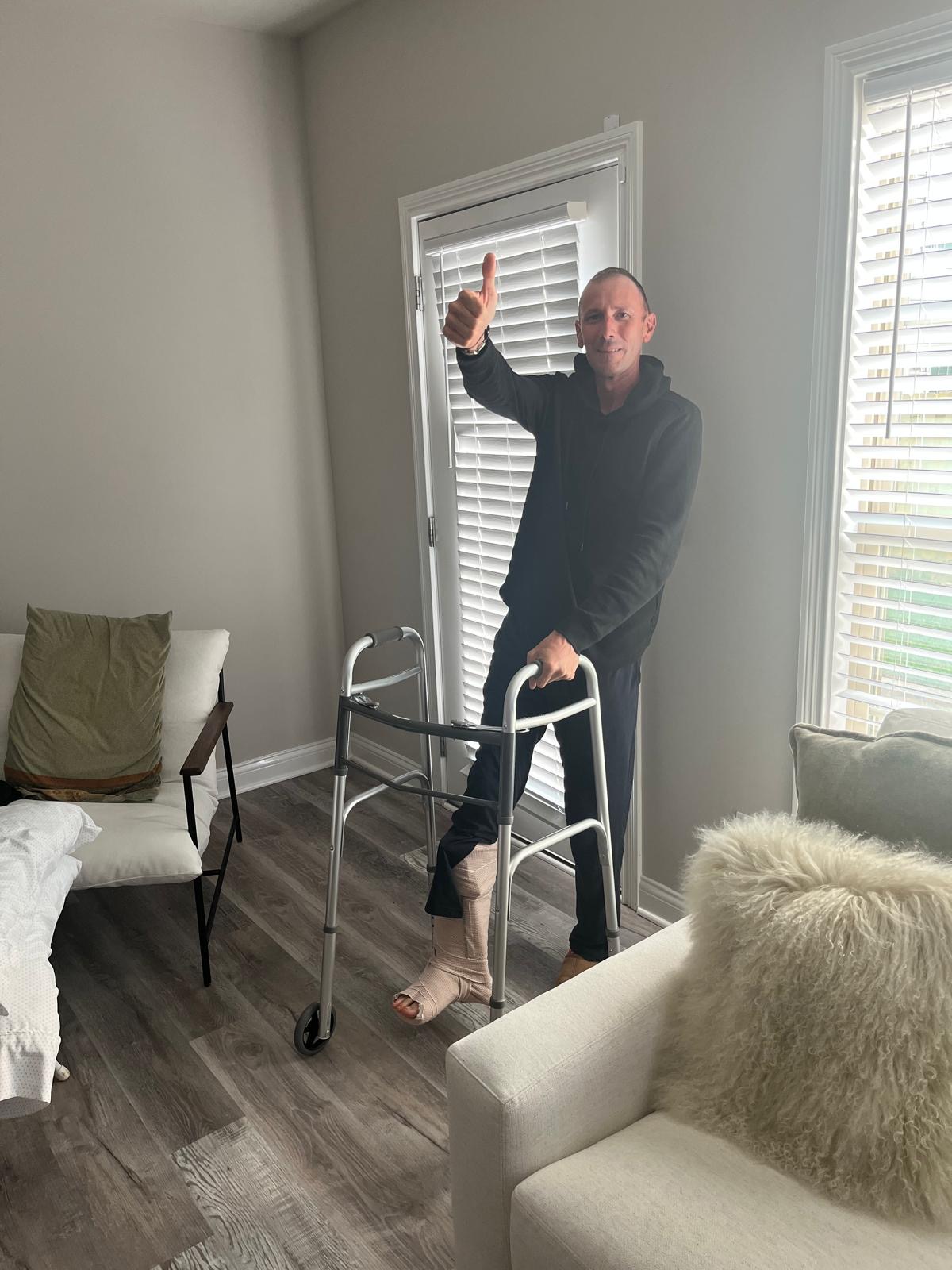
But we knew I would need another surgery, maybe more, and the doctors were considering their next steps. At that point they weren’t sharing too much with me, but eventually they told me they wanted to fuse my ankle, which would have involved putting a rod or plate and screws through the joints.
That would have protected my ankle and given me stability, but would have limited my mobility. For me, that was a terrible option, because I felt it would have been impossible to do my job—to put my heels down, or land after a jump.
I give the doctors credit, because they listened to me, and once they understood what my goal was after rehabilitation, they came up with a different plan.
Essentially, two weeks after my accident, they brought me back into the operating room, and they rebuilt my ankle the best that they could. They secured everything with a titanium plate on both sides of my leg, but they didn’t fuse the joints. The surgery went as planned, and they were happy with it.
But there were still no promises from the doctors at that point.
Everything would depend on whether or not it became infected. And, given how long I’d been down in the warm-up ring, infection was still a major concern. They told me my body’s reaction to the surgery, my own attitude, and how well I took to physical therapy and the rehabilitation process were also factors in how well I would recover.
All those things were true. But, looking back, I believe it was also something else.
I have always tried to be a healthy person, and I consider myself to be, generally speaking, pretty fit and strong. But with something like infection, and who gets it, and who doesn’t, it comes down to luck in those situations, pure and simple. That part is not in your control.
*****
After my second surgery, I basically couldn’t move for a month. I stayed on the couch, and the only place I went was to check-ups every other week with my doctors.
The first phase of rehabilitation I did was called ‘passive rehabilitation,’ meaning the physical therapists would stand at the side of my bed and manipulate my foot and ankle. Everything, at that point, was shut down, and so was the feeling in my ankle. They started, essentially, with one toe at a time.
The whole experience was like I was watching another person’s leg.
My toes weren’t moving when I told them to, and the scary thing was there was no guarantee that I would ever regain feeling in my foot. They told me, best case scenario, I would probably always walk with a limp.
That didn’t really bother me, or even the fact that I couldn’t run again. What I needed to be able to do—for my work and for myself—was to be on a horse.
I’ve always been a perfectionist, and tough on myself, especially when it comes to my riding. My biggest fear, even as I began on the path of recovery, was that I was never going to be the rider that I once was. Back then, even sitting on a horse again seemed so very far away.
That’s what really scared me. If I’m honest, that was one of the darkest times in my recovery.
I would sit there at home, after the physical therapists left, and see my leg not moving when I was telling it to. It definitely put me into a kind of depression. In general, I’m a fighter. But in those moments, I felt like surrendering.
How could I ride again if I couldn’t even move my toes?
I’m so grateful to Nicki and her family, but especially in that period, because I wasn’t at my best and they became my family here in America. They were there for me in every way when I needed them—and that’s a special thing, because it wasn’t the case with everyone.
Some people that I expected to be there for me weren’t, and that was also difficult. Many more people were, though, and I will be forever grateful to them. They gave me the good vibes and the positive support that I needed. Eventually, the clouds lifted, and I started fighting again.

Because the risk of infection was still significant, my doctors wouldn’t allow me to fly down to Wellington, where our winter farm is, until November. When I got down there, I started to increase the PT I was doing, with more weight-bearing exercises on my leg.
In January, I thought I might be ready to sit on a horse again, so I chose one of the client’s mares that I trusted. Her name was Evie, and she’s a big mare, and kind of motherly in a sense—she takes care of you. I felt safe on her and always knew she would be the one I wanted to ride first.
Fair to say, I was not scared at all to mount her, even though that was what I’d been doing when I was hurt. But when I sat down in the saddle and saw how my right leg looked at my side—just sticking out, away from the horse, with no flexion, and no mobility, I had had enough.
I told the people helping me, I was like, “Guys, thank you, but I’m not getting back on a horse for a while. Let me go back to the physiotherapist and we’ll see what we can do.”
I told myself that I was going to table my riding for a time. I didn’t want to get back on a horse until I could make my leg function the way I wanted it to, and the way I still believed that it could. I went back PT for another two months, and I worked harder than ever.
My healthcare team was still treating me very carefully, and they would only increase my exercises when my doctor in Wellington approved it, and only based on how my monthly X-Rays and MRI looked.
One weekend, after I’d had my regular scans, my doctor called me, and I immediately thought, Why is he calling me on a Saturday morning?
I was right to be afraid, because he said my MRI was concerning. He was worried that my ankle bone had stopped healing.
That was a nightmare, because the solution was likely a third surgery, which would put a cadaver bone graft (called an allograft) into my bone to help stimulate it to grow. Not only would it be a third surgery, but it came with an increased risk of infection.
They had me come back into the clinic the next week. My doctor, thankfully, had come up with another solution.
He told me that if I was willing to postpone my riding for a little longer, they could hold off on surgery and we could try a bone stimulator machine, which would use low-level electromagnetic pulses or ultrasound waves to stimulate healing in my bone.
I had to use it every day, but thank God, it worked, and my bone started to regrow.
Throughout my rehabilitation process, I had gone from using a rolling walker to get around, to being on crutches, to then using a cane. Finally, I didn’t need anything to get around with. At that point, I felt like I was ready to try riding again.
I started riding at the walk, and eventually, I began trotting. For almost an entire year, I could only do the sitting trot, because my stirrups had to be set at very different lengths—there was actually a 10-hole difference in the stirrups on my left and injured right sides.
I was also very weak on my right side, because I had lost all my muscle tone. I had to re-learn how to balance in the saddle using other parts of my leg to compensate.
I worked very hard at that, and I had people film me in the saddle so I could study my position. At first, watching those videos was very difficult: it was almost as if I was looking at another man in the saddle. I didn’t recognize myself, and that was so frustrating.
For me, this is my job—and I am very lucky that it is my job—but riding is so much more than that to me. It’s my passion and my life. The horses are a kind of sickness for me, in the best sense. I can’t be without them. But during my rehabilitation, that was always a double-edged sword.
When I could finally be back at the shows with my team, I would sit there in the middle of the ring, and watch other people riding, and help to coach, and I would be happy. But then, I would also be thinking, Is this as far as I will go? Can I walk a course again with my students? Can I ride their horses again?
Before the accident, I hadn’t spent a lot of time in hospitals or rehab centers. But in those moments, when I was struggling, I made myself pay attention to the other people there. I realized that yes, I was dealing with something major, but there were so many others out there struggling with injuries and illnesses that were far worse than mine.
When I would go to the hospital for my follow-up checkups, or to my PT appointments, and I would feel sorry about my situation, I would focus on that aspect, and what I was still able to do. That put me in a better headspace, and it made me want to work even harder.
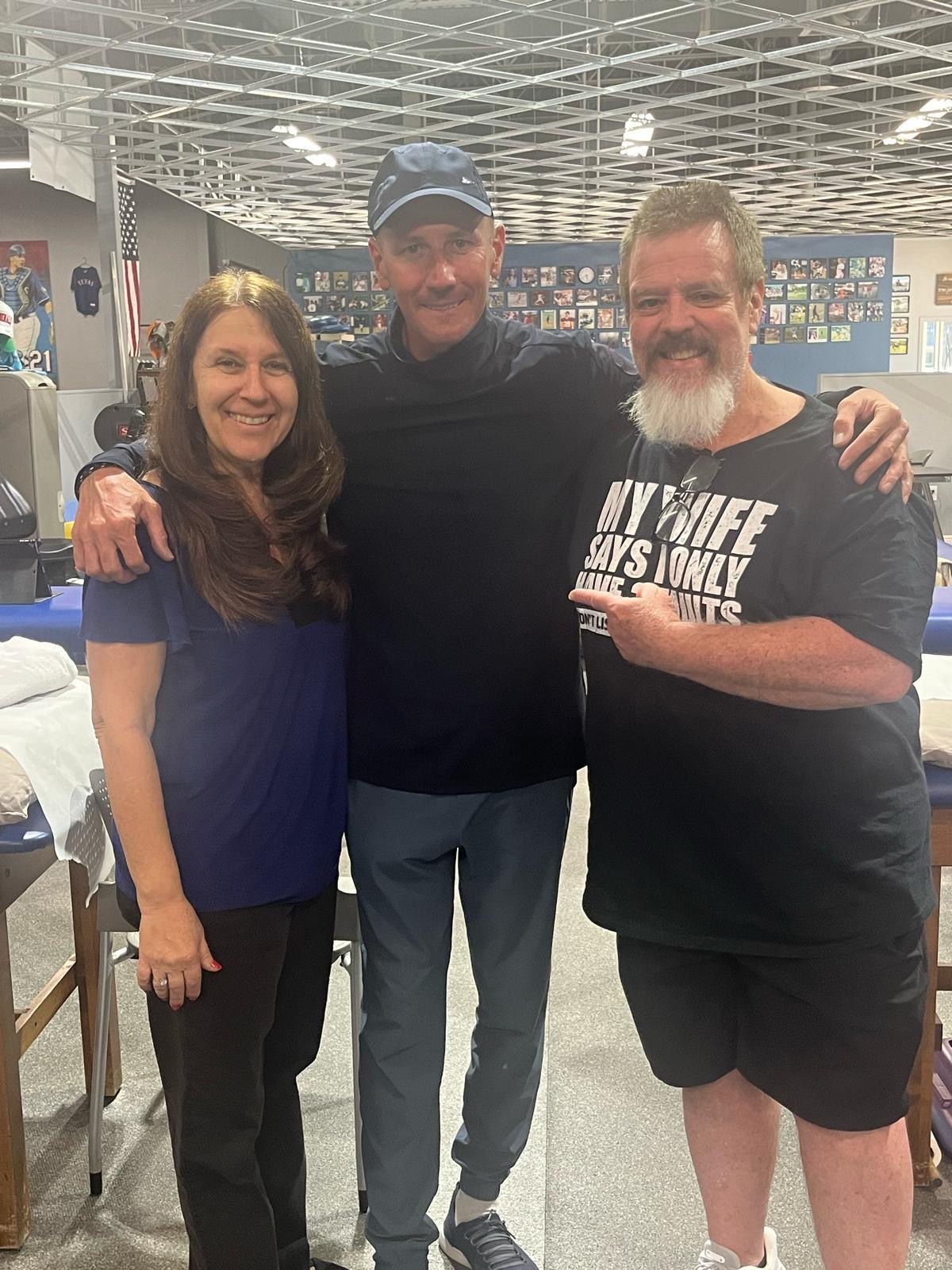
Because of the hardware in my leg, and relearning to walk on my new ankle, my doctors had to constantly check my leg for straightness. I still have monthly video calls with my PT team in Wellington so they can monitor it, and I’ll film myself riding regularly, to make sure my leg is straight, and in the correct position on the horse.
When I ride, I still don’t have full flexion in my right ankle. I can’t—as the up-down trainers always tell you—put my “heels down, toes up.” I will always have to get off on a mounting block, instead of dropping to the ground, since my doctors want me to be very careful about landing on my right leg.
That’s also the reason I have to be thoughtful about the horses that I ride, and how fresh they are. It’s not because I can’t ride through what they might do when I’m up there. The worry is that, if I ever had to jump off quickly, for any reason, I can’t land on my right leg.
I also like to joke that my dream of being a runner is over. But all that being said, there are worse prices to pay.
Today, if you didn’t know I’d had the injury, and you see me on a horse, you probably wouldn’t be able to tell. It took me a while, but I can once again walk the strides on course with our riders before a class. And, as of the last few months, I can finally post the canter again.
It took 800 days. I counted.
From the day I fell off to this September, it was 800 days until I was able to work my horses again in the posting canter. That had been a goal of mine for a long time, but I wasn’t strong enough. Now that I can do that, I would say I’m about 90 percent back to where I want to be.
That’s pretty amazing when you realize where I started.
When I run across stewards, riders, and trainers at horse shows—people who were at the Kentucky Horse Park that day—they can’t believe that someone could recover from an injury like mine. They tell me, “You’re a miracle!”
I don’t know if that’s true. But I know that if it was not for the people who stood by me, for Nicki and her family, who supported me—and kicked my butt when I needed that, too—I would not be where I am now.
I am thankful that I could wake up in the morning every day and feel lucky, because I still had the horses. I have always had the hope that I could someday get back to them. That is a gift.
What to read next: “Talk Less, Observe More: Simone Besutti Is a Horse’s Horseman”
The post Simone Besutti: “It took 800 days for me to post the canter again” appeared first on Horse Network.
Dale Harvey: “You, you’re worth it.” 20 Nov 2025, 7:42 am
Dale Harvey, a former Grand Prix rider who twice represented Canada at the FEI World Cup Finals, is now the CEO of West Palms Events, a show management company that has produced events from USEF A-rated to FEI 5* levels. In 2015, Harvey established the Michael Nyuis Foundation to help give under-resourced young riders the opportunity to compete at Hunter/Jumper competitions. This is Dale’s story, brought to you by Three Mares.
Finals, is now the CEO of West Palms Events, a show management company that has produced events from USEF A-rated to FEI 5* levels. In 2015, Harvey established the Michael Nyuis Foundation to help give under-resourced young riders the opportunity to compete at Hunter/Jumper competitions. This is Dale’s story, brought to you by Three Mares.
Michael was a daredevil.
A real sportsman. An avid skier. A snowboarder. A mountain man, really. He enjoyed lots of outdoor, adrenaline-filled activities.
This one weekend, we were up the mountain snowmobiling. It was me, two of my brothers, Michael, and a friend from Spain. Michael was going to snowboard down, which he did, and my brother was supposed to video it but he left the lens cap on the camera. So Michael went back up the mountain to do it again, and on his way down he literally set off an avalanche. As we were filming it.
It was terrifying.
With avalanches, you think that it’s all snow. Well, it’s not snow. It’s chunks of ice and debris and all kinds of stuff. Somehow Michael was able to stay on top with his snowboard and pretty much landed right at our feet where we were parked with the snowmobiles.
I remember it like it was yesterday. He stood up and he looked at us on camera and he said, “Don’t tell my mom.”
That was just Michael.
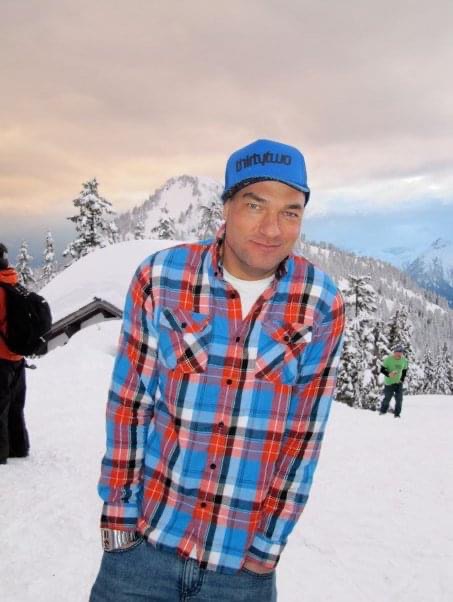
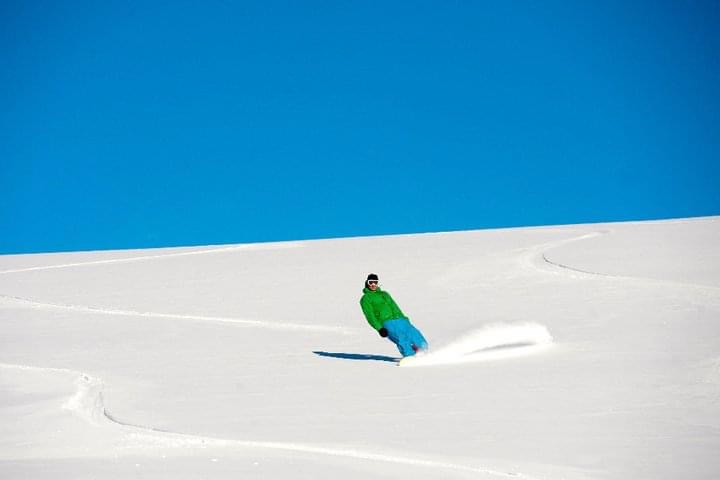
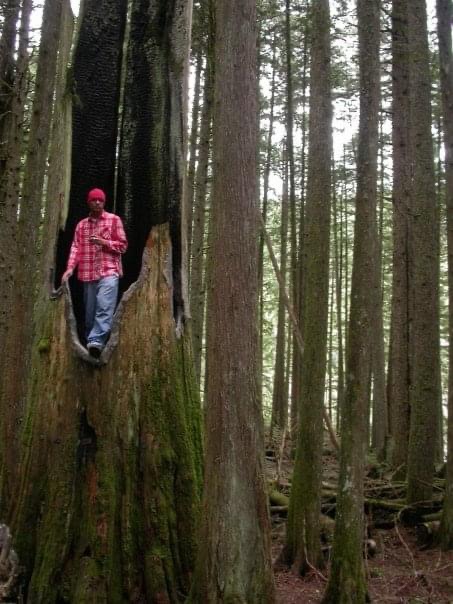
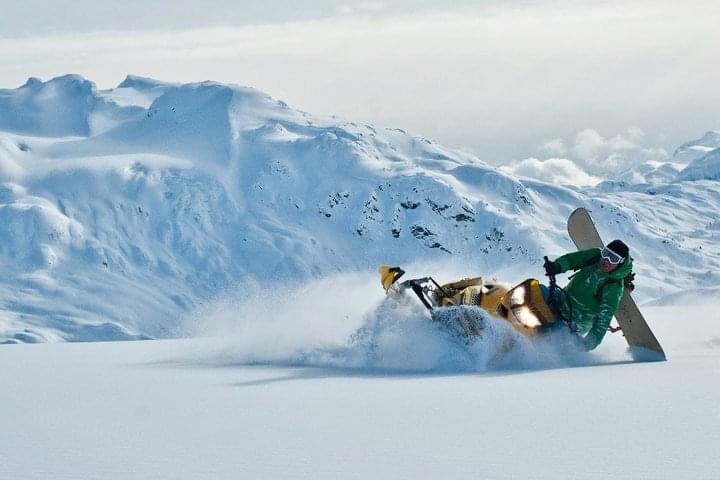
I have three brothers and three sisters. Michael was my nephew, and we were really close. In the last few years, we didn’t spend a lot of time together, but when we got together, it was like we had been together the day before.
He was just about to turn 42 when he died. He was hiking on a fairly well-known trail north of Vancouver and had a heart attack. He was so far into the trail that there was really no help, and I don’t know whether it would have mattered. That was the end for Michael—he died doing what he loved.
It’s hard losing someone so young and especially somebody that was so dedicated to helping other people. He was really a selfless individual.
I knew that about him, but it really hit home at his memorial.
The service was held in a hotel downtown. It was a huge ballroom. And I mean, it was standing room only. The crowd literally was outside the door and down the stairs into the lobby of the hotel. What I discovered in those days after he passed was story after story of him doing incredible things for people just out of the goodness of his heart and on every level—from people that were living on the streets to people that he helped with their career or whatever it was.
He really was all about that.
And he was very non-materialistic. We had talked a lot about that prior to his death, just his philosophy on greed and coveting things and wealth and accumulation. When you have money and you’re doing well, everyone is willing to help you, but when you have nothing, very few people will step up. Well, that wasn’t the case with him.
Michael’s memorial really opened my eyes. I don’t think his death changed me, but it accelerated my priorities in the way I live my life and what I was doing with my career.
At that time, I had done a lot of philanthropic work with Compton Junior Posse, an inner-city program in Compton, CA, that was working to get inner-city kids off the street after school. Will Simpson connected me with Mayisha Akbar, who ran the program, and we started doing grants for those kids to compete at my shows and to send them to the Del Mar World Cup in school busses and stuff like that just to give them the opportunity to get involved.
After Michael passed, we established it as a charitable foundation called the Michael Nyuis Foundation (MNF) to support under-resourced young riders, and eventually started to develop a little broader curriculum.
MNF began giving grants to young riders aged 14–25, who otherwise would not have been able to afford to compete, and it grew from there. Now, we do workshops and clinics with top riders like Tiffany Foster, McLain Ward, Beezie Madden, Mandy Porter, Karl Cook, you name it.
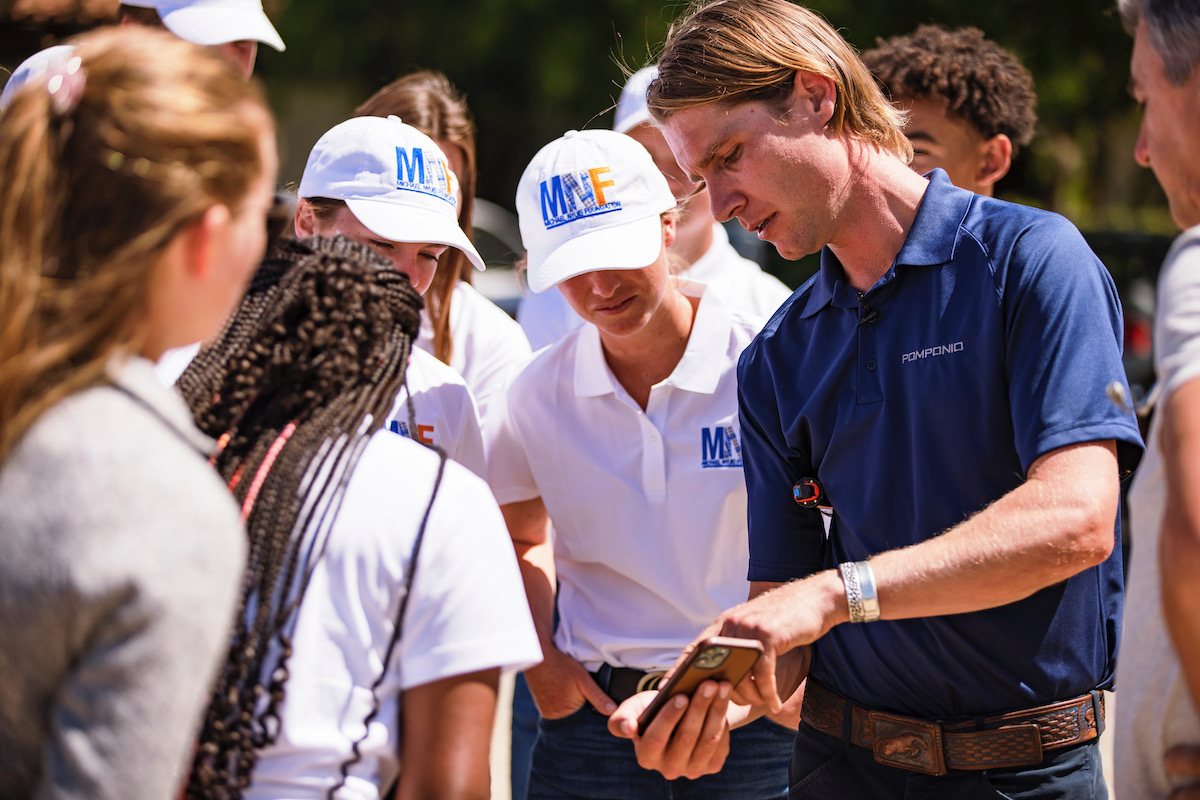
But the program goes beyond the show ring.
All the recipients have to volunteer and work behind the scenes at the shows. They put in three hours per show at West Palms Events because there’s “no free lunch in life.” A huge part of the program is the commitment and follow–through, and we’re really strict about that. They have to make sure that they’re meeting their volunteer requirements and show up on the calls. Each recipient is required to be fully engaged and make a commitment to use the grant to its fullest.
In December 2024, we hosted our inaugural Michael Nyuis Foundation Charity Horse Show in Los Angeles. All of the current MNF Grant Recipients participate in organizing and running the show. It’s a Christmas show, so it’s got a great theme and atmosphere—the vibe is like no other show we’ve ever done. All the recipients pick a department they want to work in, whether it’s finance or hiring or facility liaison, and they help with the actual production of the show.
The MNF program helps shape these young individuals, in terms of accountability, responsibility, and reliability. It hones skills that they can bring with them into the real world to college, careers, and beyond.
The difference that I see in a lot of the MNF Grant Recipients, from the beginning to the end, is the confidence that it gives them.
Just the mere fact that they were chosen is something that’s never happened to these young people before. Nobody’s ever said, “You, you’re worth it.” And, it is life-changing for many of them.
I was at one of our shows in Los Angeles this summer and I had four kids come up to me that are now young adults and all four of them said, “I’m working for so-and-so and I’m so-and-so’s assistant and if it wasn’t for this program, I would never have been able to get to this point.” So, we have a huge track record.
Skylar Wireman, Amanda Gomez, Trent McGee, and Ian McFarlane were all in the program. We have probably over two dozen past recipients who are now young, successful equestrian professionals. It’s amazing and I’m very proud.
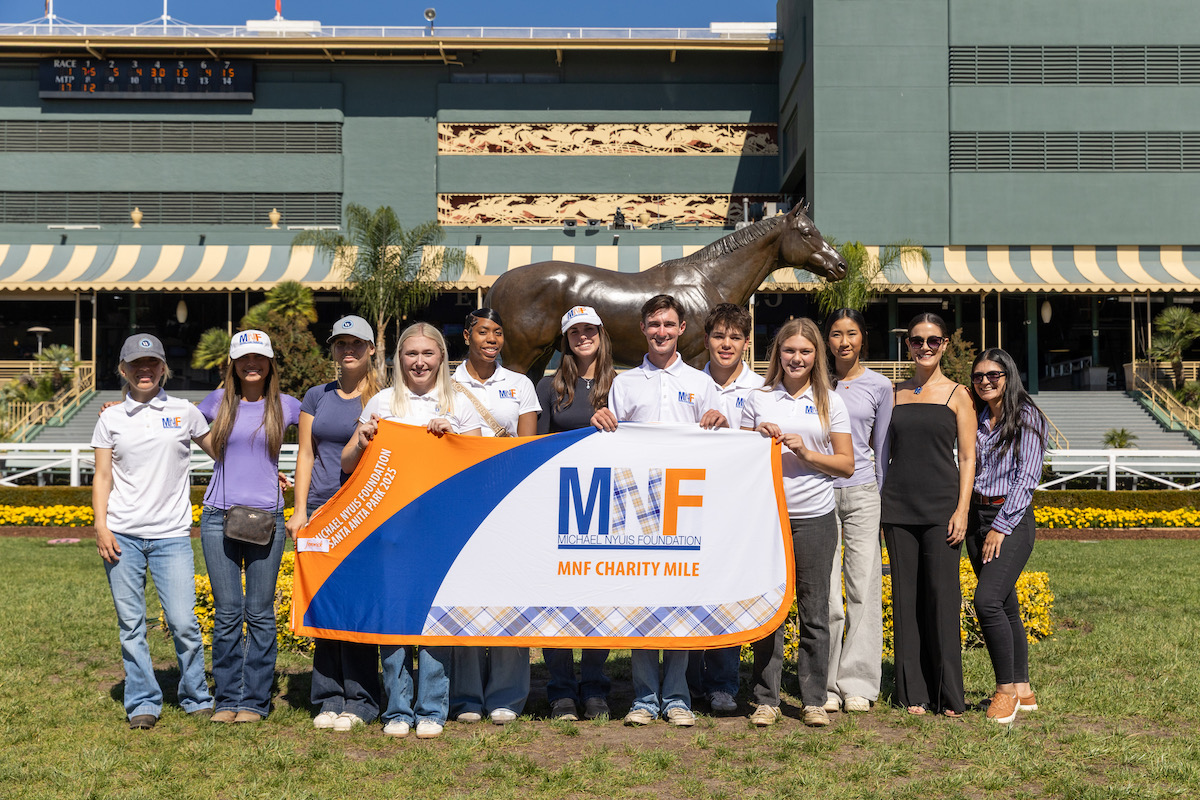
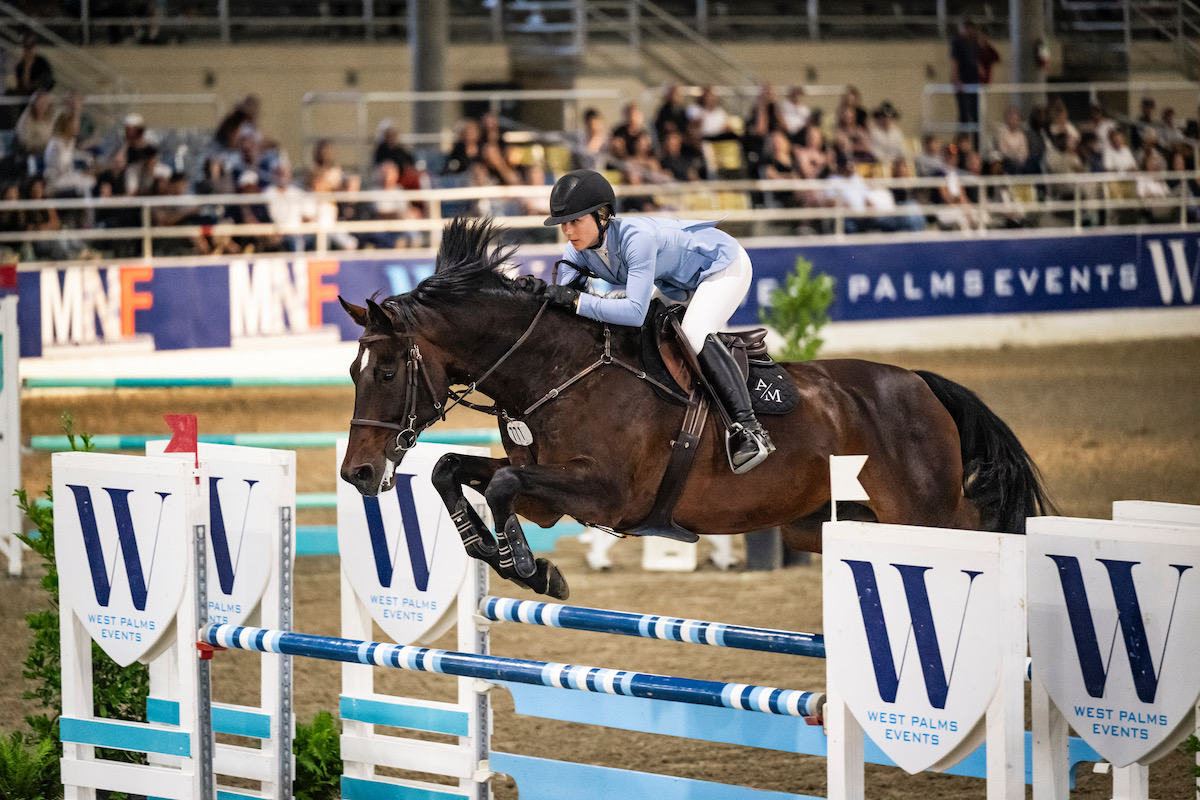

But there is still so much more we want to be doing.
There are supposed to be 12 recipients every year, but it always ends up being 18 because we can never get it down to 12. Last year, we had over 150 applications and at least 50 of them deserve to be in the program.
And that’s the hardest part. Because I understand what it’s like not to have access—I didn’t have it as a young rider either.
I grew up in North Bay. It’s a remote part of Ontario. There’s no show barn there. There were five or six horses, a couple geese, and some chickens. We didn’t have a ring. We didn’t really have jumps. I made the course out of whatever I could find on the farm—telephone poles, barrels, 50–gallon drums, all this junk basically. I would take these horses that my dad would find and make them work. As I got a little older, I ended up with a horse that I was able to go and do some junior jumper stuff with down in Southern Ontario and Toronto. It was just unlikely that I would end up in this industry or this business.
But through the help of a lot of different people and an obsession with it, I was able to make something happen. I have a list of folks that have helped me at different stages along the way: my parents, Mike Grinyer, Kenny Nordstrom, and Scott King, Kyle King’s dad. I mean, I have to do it for somebody else, obviously.
So that’s what I’m trying to do with the Michael Nyuis Foundation.
I want to try to expand it in terms of what we’re able to do for the recipients. I want to get to where we can provide help for kids wanting to do the medal finals and Young Riders, to give them opportunities outside of West Palms Events and our partner shows. But it comes down to fundraising and growing our donor base. For many years, I funded the foundation on my own, with the help of a few donors along the way. We are looking to take the Foundation to the next level.
We’re in our tenth year for MNF and we just passed a million dollars in grants.
I have moments where I think, ‘What are we doing?’ We should be feeding homeless people and doing something more basic. Or I get frustrated with the industry. But I think that the benefits of the program are so much broader than riding and competing. I think the riding part is really a footnote.
What keeps me motivated is our mission to try to give those young people an opportunity they wouldn’t otherwise have. I believe Michael would be proud of that.
I always sort of give my head a shake and wonder, what would he think about his name being out there like it is? Just the fact that people can pronounce it! It’s a well-known name now. I think he would laugh about it. He would think it was pretty funny.
Interested in supporting the Michael Nyuis Foundation? Head to nyuisfoundation.org to learn more.
Michael Nyuis Foundation is a 501(c)(3) non-profit organization: EIN # 87-3490307.
This story is brought to you by Three Mares, is a purpose-driven collective of equestrian brands—Dreamers & Schemers Socks, The TackHack, and ManeJane—that donates 100% of its profits to organizations working to make equestrian sport more accessible, safe and inclusive of all athletes. Like the Michael Nyuis Foundation. Learn more at thethreemares.com.
The post Dale Harvey: “You, you’re worth it.” appeared first on Horse Network.
William Greve’s Pretty Woman Van’t Paradijs N.O.P. Is Ready for Her Close-Up 17 Nov 2025, 10:34 am
In a winning jump-off round, there’s often a make-it-or-break-it moment that marks the sometimes razor-thin line between victory and defeat. For the Netherlands’ William Greve, that moment was undoubtedly jump-off Fence 5 during the fourth leg of the Longines FEI Jumping World Cup qualifier season at the Stuttgart German Masters.
qualifier season at the Stuttgart German Masters.
After a relatively conservative start to Course Designer Christa Jung’s (GER) looping, second-round track, Greve and Pretty Woman Van’t Paradijs N.O.P.’s bold gallop around the end of the arena snowballed into an unexpected flier at the wide, green oxer—requiring his 10-year-old Belgian mare to, essentially, grow wings and fly.
“He got away with it! Well, he had to take a chance somewhere,” Commentator Alice Watson reflected, aghast. But Pretty Woman’s confidence in her longtime rider didn’t waiver.
Greve quickly regained his composure and managed to rein-in Pretty Woman’s growing excitement, using her impressive power and stride-length to complete the rest of the course without fault. The pair stopped the timers at 44.62 seconds, securing the win.
“This feeling, this is what we do it for—the adrenaline is unbelievable, the relief,” said Greve, who currently sits at #37 on the Longines Rankings. “It’s been a long weekend, I only had two horses here, but winning as the last competitor in the jump-off, for the amazing crowd here in Stuttgart, it’s a dream come true.”
Portugal’s Rodrigo Giesteira Almedia was second with Karonia L on 45.08 seconds, while Peder Fredricson (SWE) and Alcapone des Carmille rounded out the podium on 45.29 seconds.
“I knew my jump-off [time] was not unbeatable, but, okay, I’m against the best horses and riders in the world,” Giesteira Almedia said. “I tried to make up my time as much as I could until the end, and it worked out—until the last rider! But that was Willem Greve, one of the best riders in the world. I have no words to describe how proud I am of Karonia.”
Carefully produced by Greve since her 6-year-old year, Pretty Woman Van’t Paradijs N.O.P. made her championship debut last summer at the European Championships in La Coruña, Spain. Together, they have finished on a total of six podiums at 1.50m and higher, and with this—their first 5* Grand Prix win—the pair adds their name to a list of just four, 9- and 10-year-old horses to win a 5* 1.60m Grand Prix so far this year (Jumpr Stats).
Brazil’s Yuri Mansur, who finished 6th with QH Alfons Santo Antonio in Stuttgart, has moved to the top of the Western European League Standings on 28 points. Alain Jufur of Switzerland sits in second with 26 points, while Daniel Deusser (GER) and Johan-Sebastian Gulliksen (NOR) tie for third on 25 points.
Next up: the series moves on to La Coruña for its fifth leg, taking place December 5-7.
For Greve, this career-high win with Pretty Woman, who he co-owns with Gerda Korbeld, was particularly emotional. “Pretty Woman is a very special mare to me,” he said, noting that Gerda’s husband, Dutch sport horse breeder and sponsor Gerard Korbeld, passed away last year. “I’m sure [Gerald is] somewhere up there, and he sees it,” Greve said.
“This mare is part of the family, and she will never leave.”
The post William Greve’s Pretty Woman Van’t Paradijs N.O.P. Is Ready for Her Close-Up appeared first on Horse Network.
Conor Swail Takes Toronto, Adds 8th World Cup Title to His Resume 17 Nov 2025, 10:29 am
Taylor Swift says that “life is emotionally abusive.” So is show jumping.
That’s the thought running through my mind during Conor Swail’s post-round interview with CMH TV on Saturday. Swail had just won the Longines FEI Jumping World Cup Toronto. It’s his career eighth World Cup qualifier win—he previously picked up titles in Vancouver, Sacramento, Fort Worth, Washington and Las Vegas. And his first victory in Toronto.
But for a rider who routinely ranks near or on the top of the North American League (NAL) standings, the slight tremor in Swail’s voice sounded more quietly relieved than exuberant in that moment.
“I really wanted to win this one. I actually have been placed a lot of times. I don’t think I’ve actually managed to win it. For me there was a great opportunity there tonight to do it, and I tried to grab is with both hands,” said Swail.
“I’ve produced this horse. Casturano is my top horse at the minute and he’s an incredible athlete. As much as it’s a great win for me, he really deserves it more than me. He’s been knocking at the door. The first two World Cups [this season] he was clear and I managed to mess it up with a time fault [both times]. Thankfully today, we go it all right together.”
Swail worked for the win in Toronto, too. The Irishman lost his stirrup in the first round, jumping the final three fences without his right iron. In the jump off, the pair were last to return and, chasing the time to beat set by Skylar Wireman and Barclino B, found a reins flapping flier to the Longines oxer at fence two, before finding their rhythm.
“When he jumped [Fence 1], he was a little slow on the turn. I saw a really big distance, and he didn’t really go for it in the beginning. [The jump] was getting further and further away,” Swail said. “He was very good to pick up there, but it actually got him going…The rest of the round he was really on the bridle and taking me to the jumps.”
Swail now sits atop the NAL standings on 38 points, following their eighth and ninth place finishes in Traverse City and Washington, respectively, and win in Toronto. He said that the Final in Fort Worth is his goal this season.
“This year, I feel that Casturano is ready to do it. He’s jumped at the five-star level for two years now, so I think that he can give it a good run. He’s an incredible athlete, and he jumps an awful lot of clear rounds, which is what you need to do at the Finals.”
The North American League next stops in Los Angeles (USA) on Saturday, November 22, 2025.
The post Conor Swail Takes Toronto, Adds 8th World Cup Title to His Resume appeared first on Horse Network.
Canadian Hall Of Fame Inductee Touch Gold Crosses Final Finish Line At Old Friends 15 Nov 2025, 8:09 pm
Old Friends Thoroughbred retirement home in Georgetown, Kentucky announced Thursday that 1997 Belmont Stakes (G1) winner, Touch Gold, was humanely euthanized at age 31 “due to the infirmities of old age.” A resident at Old Friends since 2015, Touch Gold was long a favorite among visitors to the popular home of pensioned Thoroughbreds.
“Saying farewell to Touch Gold is really hard for everyone at Old Friends. This tough old racehorse has been a special part of our life for many years. It was clear that he loved his life at Old Friends and enjoyed all the attention he received. Touch Gold was one of the best in a great era. We will miss him every day,” said John Nicholson, President and CEO of Old Friends.
Touch Gold was best known for denying Bob Baffert-trained Silver Charm the American Triple Crown by winning the 1997 Belmont Stakes under jockey Chris McCarron, 3/4 of a length ahead of the aspiring Triple Crown challenger. He also won the Haskell Stakes (G1) that year as well as the Lexington Stakes (G2) at Keeneland, KY. Touch Gold did not run in that year’s Kentucky Derby (G1), but did run and finished fourth in the Preakness Stakes (G1).
“Touch Gold was a terrific racehorse,” recalled Belmont Stakes partner and Hall Of Fame jockey Chris McCarron. “Along with his talent, he demonstrated tremendous courage and will to win. I was so excited and pleased when he joined the many wonderful thoroughbreds at Old Friends, which gave me the opportunity to visit him and thank him for all the thrills he provided me. I will miss him.”
The son of Canada’s Deputy Minister (by Canada’s Passing Mood out of Buckpasser) compiled a 15: 6-3-1 racing record and earned $1,679,907. He was inducted into the Canadian Hall of Fame in 2011.
In one of the ironies that often occur in racing, both Touch Gold and Silver Charm, the horse he denied the Triple Crown by winning the 1997 Belmont Stakes, were both pensioned to Old Friends in 2015 after stallion careers in New York, and Kentucky and Japan respectively.
Silver Charm, also 31 as of May, now becomes Old Friends oldest living resident.
The post Canadian Hall Of Fame Inductee Touch Gold Crosses Final Finish Line At Old Friends appeared first on Horse Network.
The “Do Good” Gift Guide for Equestrians 14 Nov 2025, 1:30 pm
This holiday season, give good!
Every product in this Three Mares gift guide gives back to athletes. Like you. Because all profits from Three Mares brands—Dreamers & Schemers, The TackHack, and ManeJane—go to non-profits working to make horse sport safer, more inclusive, and more accessible for athletes. Like you.
So every gift you give is also a gift to the sport you love. (And to you!)
Stocking Stuffers
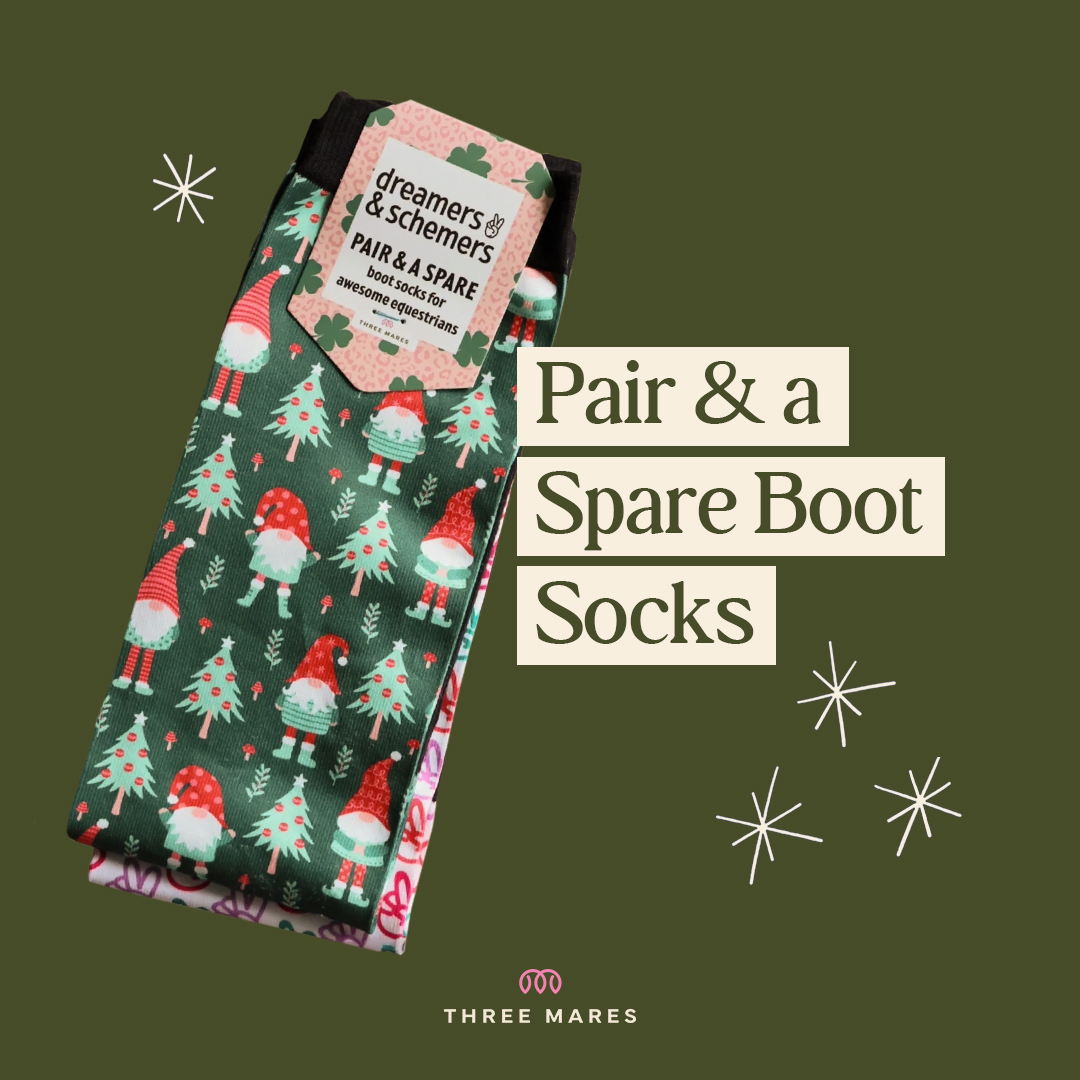
Pair & a Spare Boot Socks | $17.95 USD
One pair + single spare! (In case the dryer troll gets hungry…) Buying 2 pairs magically gives you THREE PAIRS! D&S Boot Socks are as fun as a paddockful of frisky foals and hold their shape and colors wash after wash.

D&S Crew Socks | $14.95 USD
Designed with cheeky patterns and 92% cozy cotton comfort, D&S Crew Socks are one-size-fits-most (6–10) and super stretchy—perfect for surprising your barn besties.
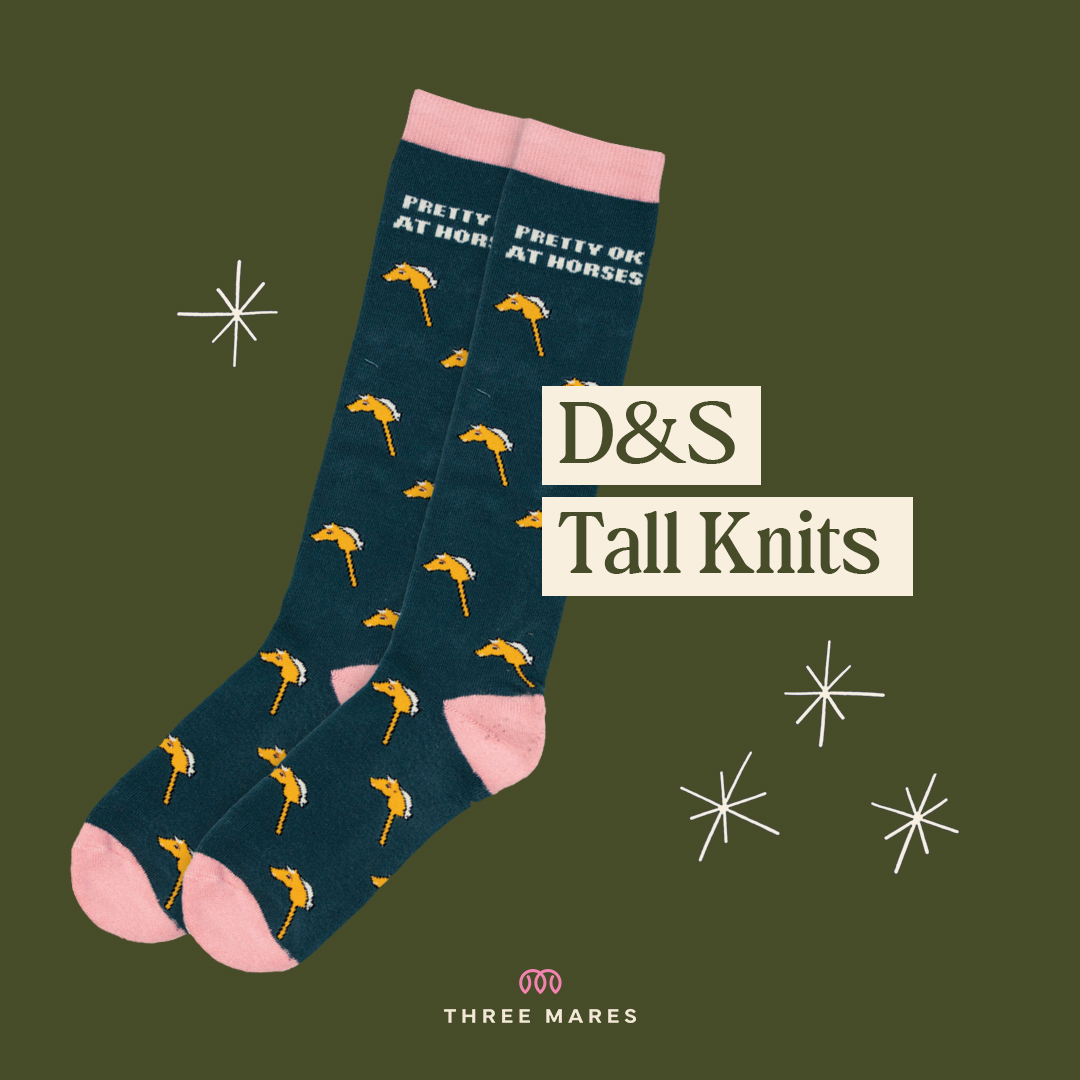
D&S Tall Knits | $16.95 USD
Loaded with extra cushion in the footbed and cheeky sayings, there’s a D&S Tall Knit for every hardcore rider, horse-obsessed friend, and “fun sock dad” on your list. There’s even one for the ‘boring sock’ equestrian. (You know the one.)

Donut Sponges | $13.95 USD
Who says cleaning tack can’t be fun? Not these donut-themed tack sponges! Sold as a pack of six.
For the Rider Who Has Everything
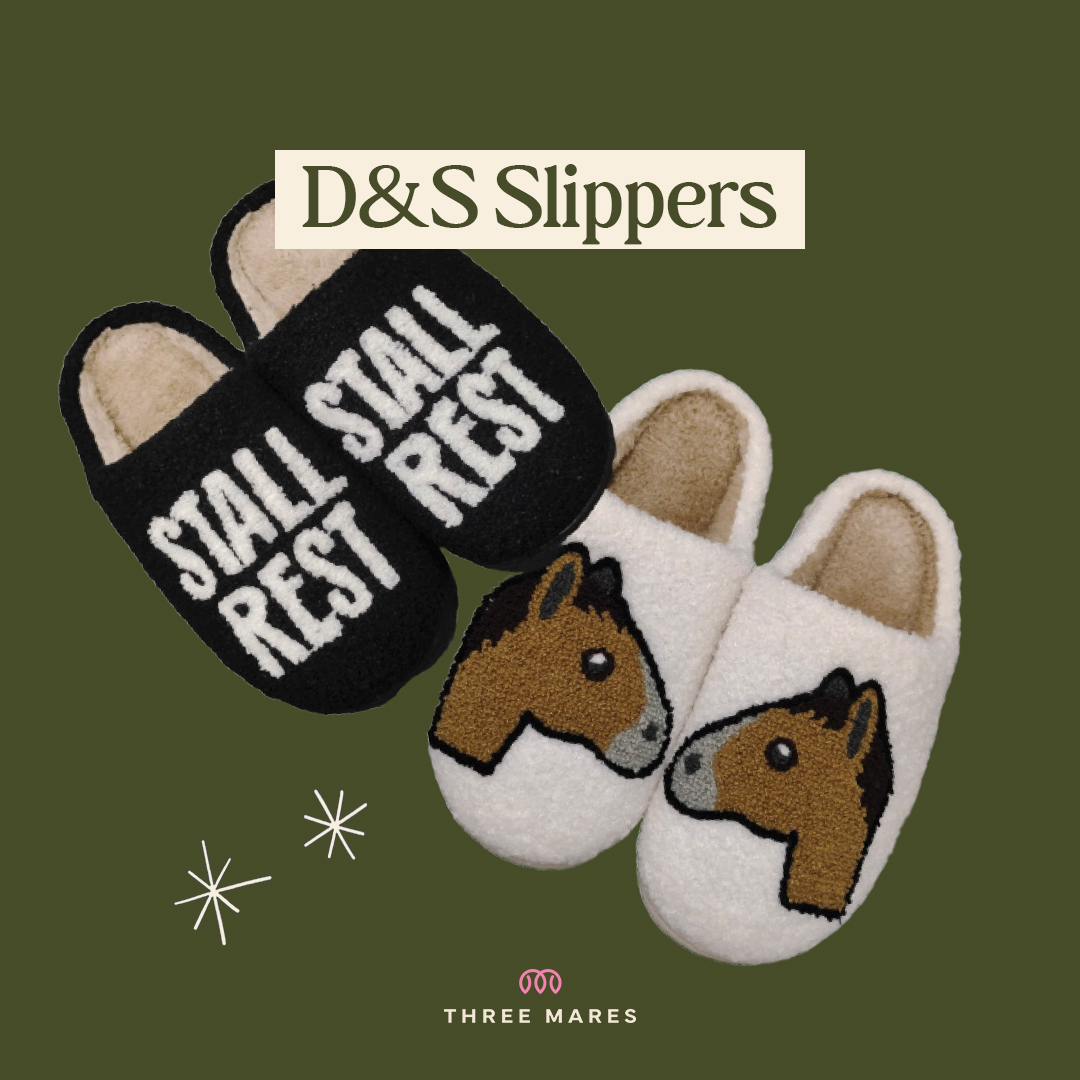
D&S Slippers | $29.95 USD
Wrapped in fuzzy sherpa fleece and lined with silky-soft faux fur, D&S slippers are designed for sweet barn boot relief but durable enough to sprint out for night check because someone forgot to latch the gate (again).

ManeJane Holiday Charms | $32.95 USD
Your barn friend with stall front decked for the season? This classic black leather spur strap with a festive twist is for them to bust out this year and every one after.

Premium All Around Trucker Hats | $36.95 USD
Every rider suffers from helmet hair. Which means every rider can use a sassy Trucker Hat. It’s a can’t go wrong classic.

ManeJane Reversible Belts | Straps $59.95 USD & Buckles $39.95 USD
Sized to pair with breeches or denim and crafted from premium leather, the ManeJane reversible belt is like two gifts in one. Add a signature Stirrup Buckle and you’ve got an equestrian-inspired accessory that transitions effortlessly from barn to brunch. (Belts & Buckles sold separately.)
Gifts as Unique as Your Barn Family
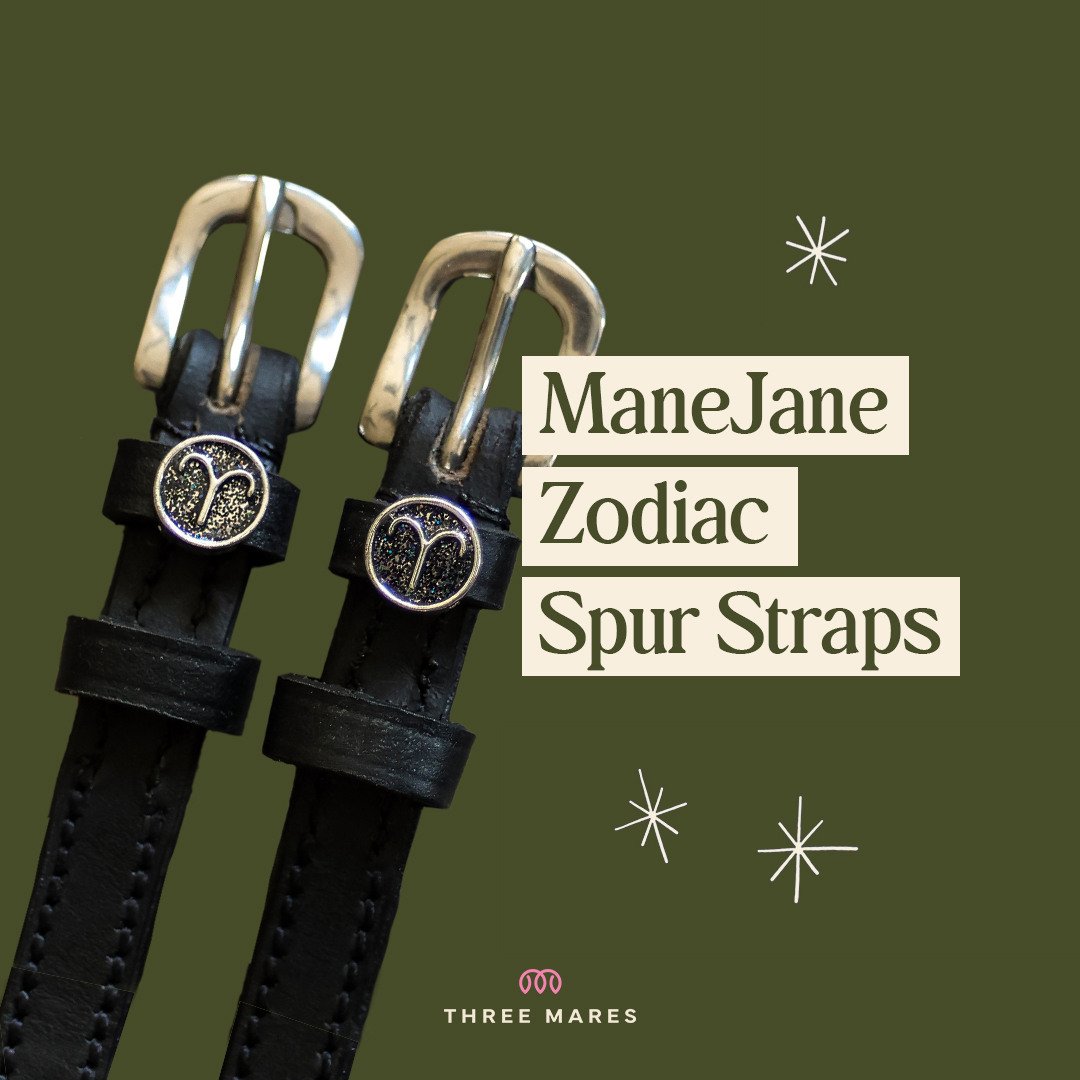
ManeJane Zodiac Spur Straps | $32.95 USD
Subtle, traditional, yet unmistakably personal. ManeJane Zodiac Spur Straps are crafted from durable black leather with a nonstretch interior, stainless steel buckle, and custom zodiac charm. Get one for the rider’s sign, and one for their horse’s!
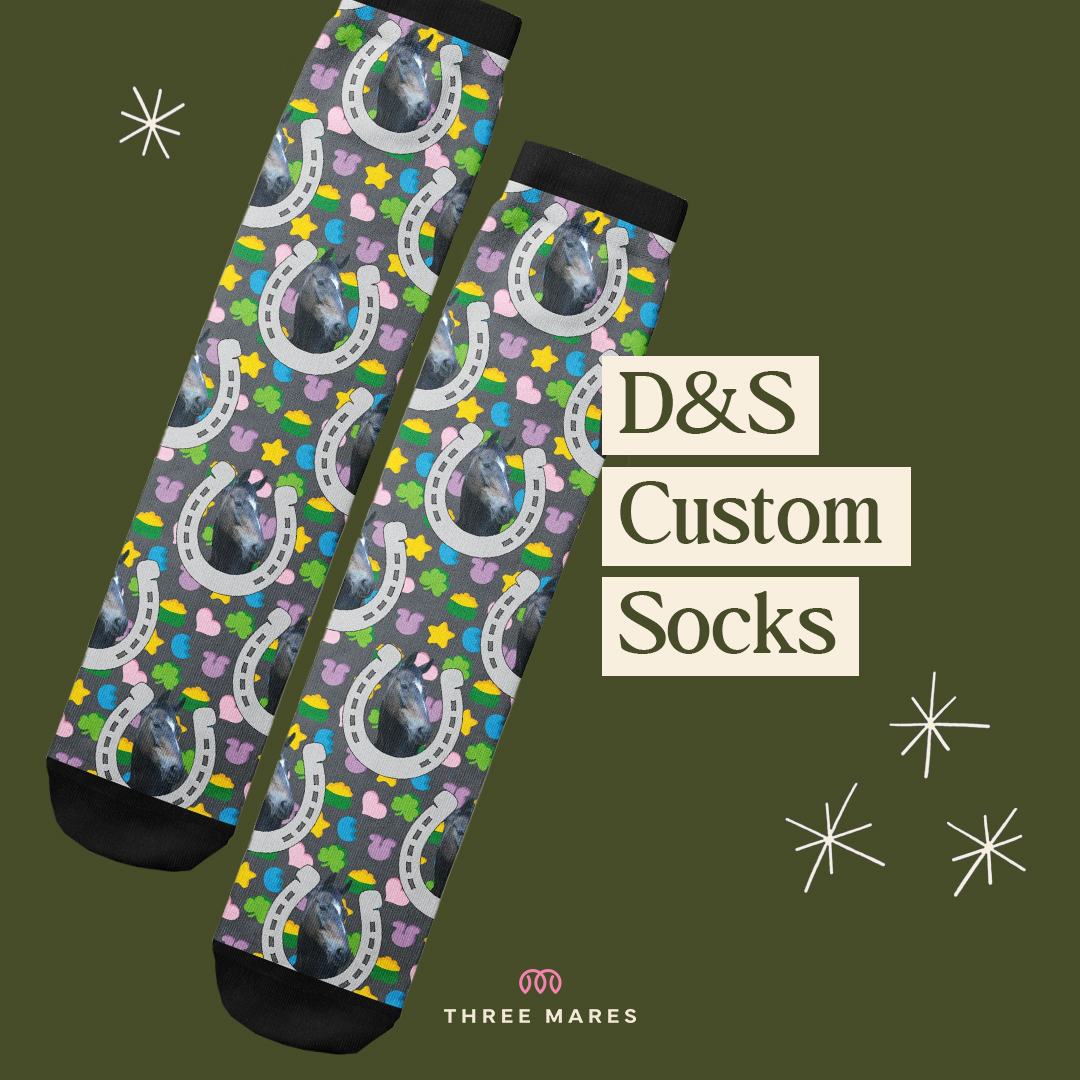
D&S Custom Socks | $29.95 USD
Custom socks for your barn crew? INSTANT CLASSIC. And it’s easy as 1. (pick your pattern), 2. (pick your background color), 3. (upload your photo). Boom! Your custom socks will printed just for you in 5 business days.
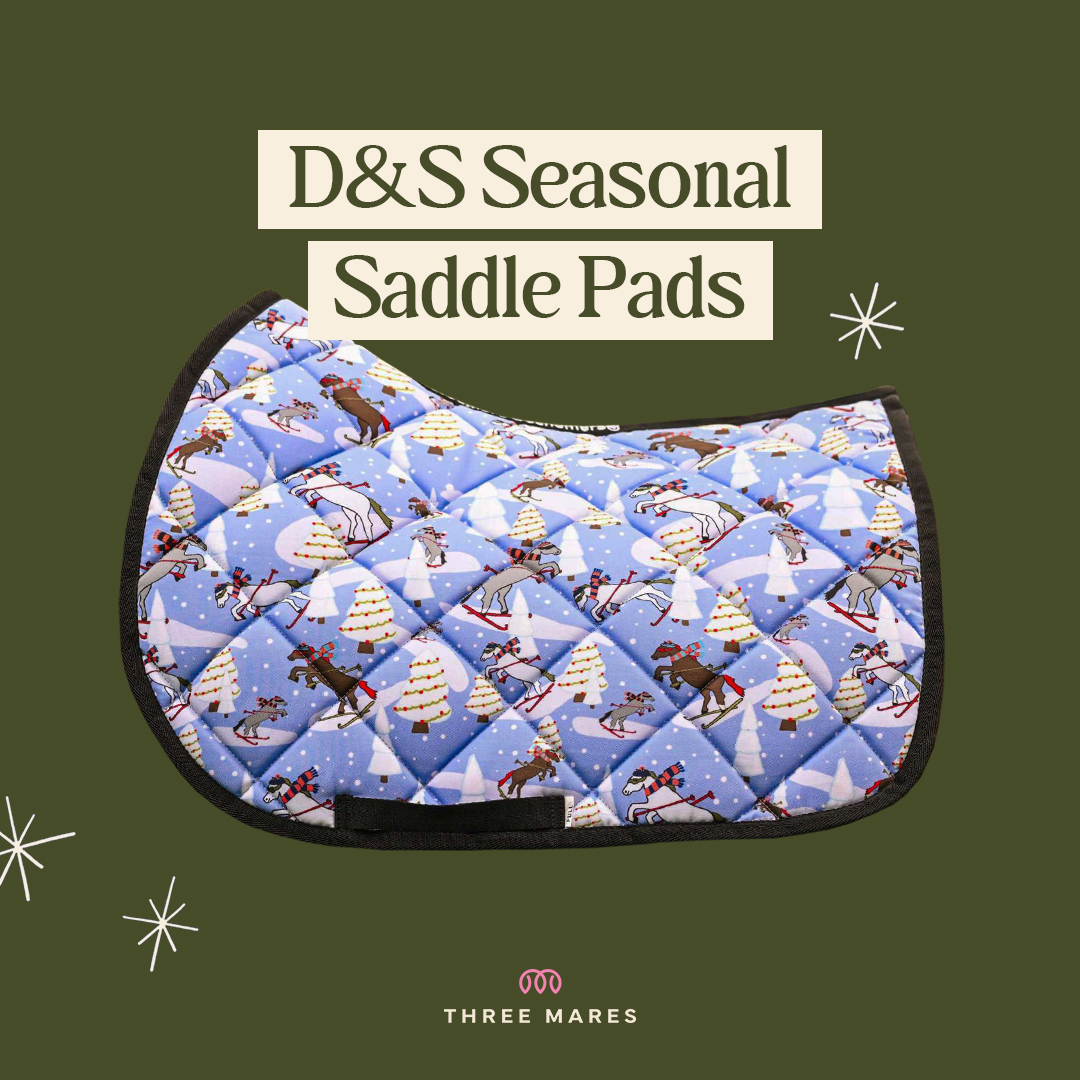
D&S Seasonal Saddle Pads | $49.95 USD
These aren’t your grandma’s saddle pads. With bold prints, breathable mesh unders, and just 75gm of fill, D&S Seasonal Saddle Pads are slim, sturdy, and just rebellious enough to make the barn moms whisper.
Gifts For Your Horse

The Perfect Bridle | $184.95 USD
Ready to wear and designed with an extra-wide noseband and signature southwest stitch, The TackHack Perfect Bridle blends classic elegance with modern flair. Get a luxe look without the lofty price tag.
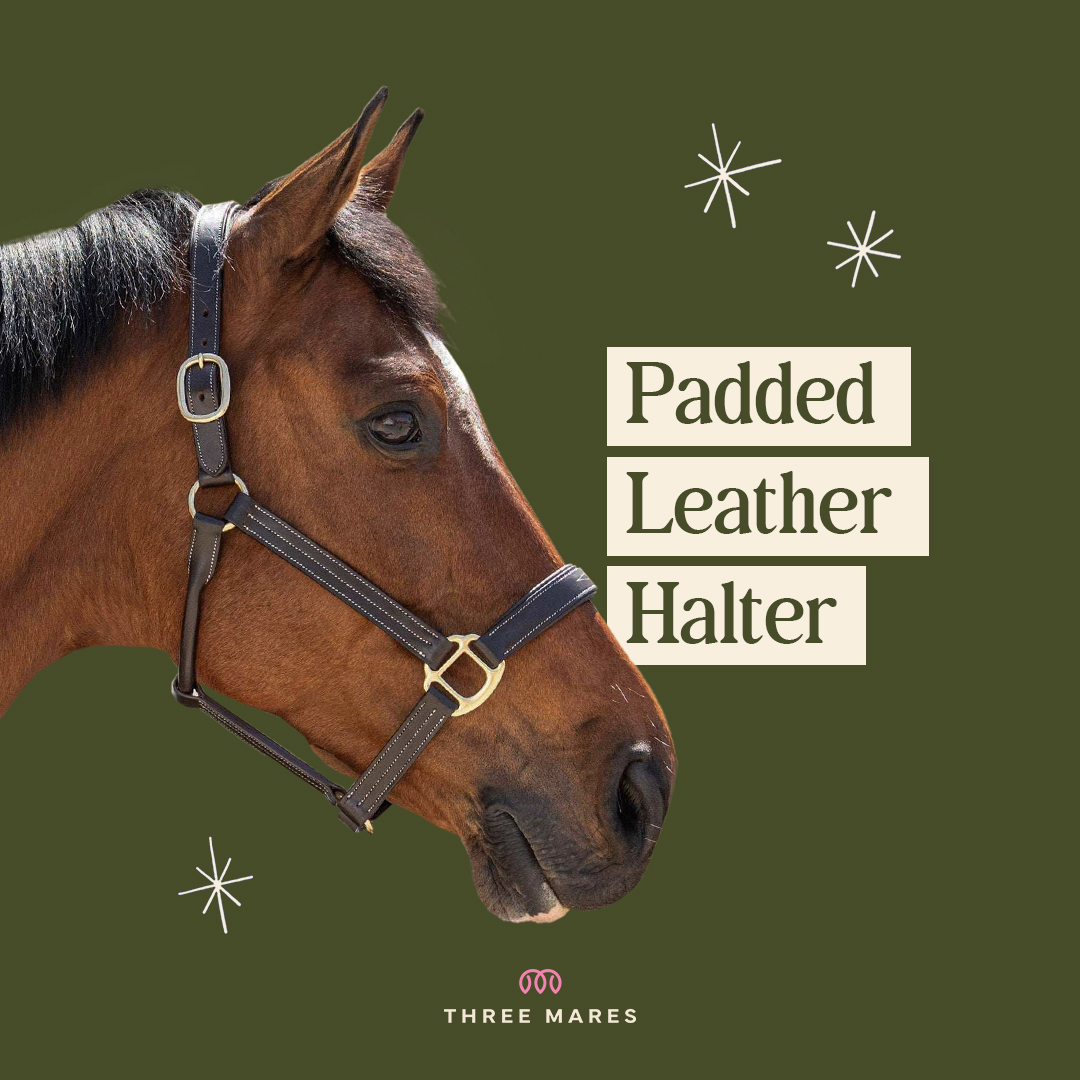
Padded Leather Halter | $135 USD
Because your horse is on the nice list, too. With a padded crown and noseband, elegant fancy stitching, and a straight chin design, The TackHack’s buttery soft, ultra-premium padded leather halter feels broken in from the start and offers comfort without compromising style.
Check out Dreamers & Schemers and ManeJane for more great gift ideas!
Three Mares is a purpose-driven collective of equestrian brands—Dreamers & Schemers, The TackHack, and ManeJane—that donates 100% of its profits to organizations working to make equestrian sport more accessible, safe and inclusive of all athletes. Learn more at thethreemares.com.

The post The “Do Good” Gift Guide for Equestrians appeared first on Horse Network.
Laura Kraut Is Keeping It 100 at 60 14 Nov 2025, 5:44 am
Trotting across the green expanse of the Dublin Horse Show Grand Prix field this August, Laura Kraut and Bisquetta—head up, ears pricked—seemed to know there was something on the wind.
Alan Wade’s towering Rolex Grand Prix of Dublin course had so-far decimated the starting list, with no shortage of the Irish Course Designer’s trade-mark wide oxers and tricky tests: a related distance from the open water to a tall plank jump, and delicate verticals sprinkled throughout. Kraut was 38th to go on the startlist of 40, with an unlucky-13 riders already retiring—and still—not a clear in sight.
The crowd was weary, presuming that, even in the best-case scenario, Kraut—legend that she is—was destined to add her name to the near-dozen of 4-faulters already watching from the stands. But not today.
As it happened, the American rider and the 11-year-old Zangersheide mare rode every stride, passed every ‘Wade-centric’ test, and generally gave a masterclass in show jumping at one of the sport’s most lauded events.
Quickly recovering from their doubts, spectators in Dublin and glued to livestreams all around the world rubbed their eyes and collectively guffawed. Well, of course Laura Kraut could do it! If not her, then who?
Who indeed? Having earned her reputation as one of the sport’s flintiest riders, Kraut is a three-time Olympic medalist (two silvers in Tokyo and Paris; gold in Beijing), a World Championship gold (2018) and silver (2006) medalist, and a Pan American gold medalist (2023).
In an international career that’s spanned more than three decades, Kraut has earned just under €6.5 million, finished on 173 podiums at 1.50m and higher, and won a total of 19 Grands Prix since 2015 alone, according to Jumpr Stats. She’s also been a long-serving and much depended-upon member of the U.S. Showjumping Team, with scores of Senior Nations Cup appearances on her resume.
But what’s really amazing is that, today, as Laura Kraut celebrates her 60th birthday, she’s also enjoying one of her most successful seasons ever in the sport of show jumping.
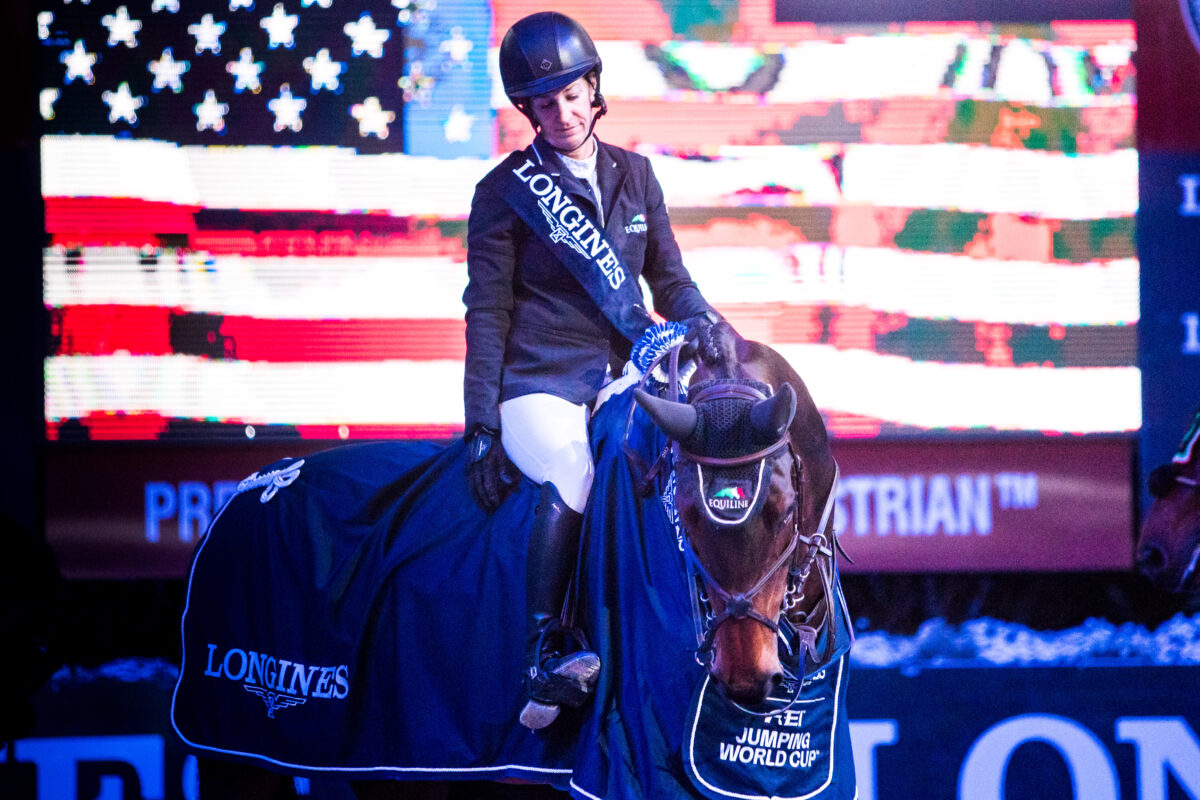
This year, for the first time in her career, Kraut has notched two, 5* Grands Prix at two very different types of venues. The first at the Rolex Grand Prix of Dublin in August with Bisquetta, and the second, last month, in the Longines FEI Jumping World Cup Washington President’s Cup Grand Prix with Tres Bien Z.
Kraut has also earned her highest position to date—no. 8—in the Longines Rankings, becoming the first woman to crack the top 10 since 2021. What’s more, she currently has a considerable string of talented, up-and-coming horses to back her play (think: the 10-year-old Zangersheide gelding Tres Bien Z, the 9-year-old OS gelding Emeraldo 4, and the 9-year-old Westphalian mare Una Mariposa).
With 16, 5* podium finishes at 1.50m and higher this year, Kraut sits in the top 10 riders in the world by that measure, tying Conor Swail (IRL) and reigning Olympic Champion Christian Kukuk (GER) at 16 a piece. In fact, Kraut, herself, is trending above average at the championship height on all horses—earning a 44% clear rate this year at 1.60+ compared to her career average of 39%.
When one compares that to her top 10 finish percentage, the picture gets even rosier. While Kraut’s career top 10 finish rate is an impressive 48%, this year, her number has jumped to a whopping 62%—a 14% improvement on her 12-year career average (Jumpr Stats).
In other words, three decades on, Laura Kraut isn’t just at the top of her game, she’s riding better than she ever has. So Happy Birthday, Laura—60 sure looks good on you!
The post Laura Kraut Is Keeping It 100 at 60 appeared first on Horse Network.
Harry Meade On His Stirrup-Length Evolution 12 Nov 2025, 7:11 am
A couple of decades ago, the World’s No. 1 eventer, Harry Meade, was cutting his teeth in the hunt fields of Great Britain. “I was probably about in my early 20s, out hunting—where you’re basically going cross country—and I was riding lots of different horses for other people,” Meade says.
The diversity of the terrain and the different types of horses he was riding offered Meade a unique opportunity to experiment with how different stirrup lengths affected his balance, and the way his horses responded.
“I went up to what was quite short—it was cross-country length—[and then] I went up another four holes again. And then I went down a lot; I would just play around,” he says.
“[I was] riding all kinds of horses, a lot of them I didn’t really know, and [jumping] big, high hanging gates, and big hedges, and doing it on all types of horses who aren’t necessarily all brilliant horses. But that [became a kind of] sketchbook for me to be able to put my ideas into place.”
Cut to the year 2025 and Harry Meade’s ideas—stirrup length notwithstanding—are very much in demand.
The 42-year-old World Equestrian Games team silver medalist (2014) who took over the No. 1 spot in June will very likely close out the year at the top of the FEI Eventing World Athlete Rankings after a history-making 5* season.
This year, Meade earned six, top-10 finishes and finished clear and in the time at three different 5* events, becoming the first rider ever to do so. He earned third with Et Hop Du Matz and fourth with Grafennact at the Defender Kentucky Three-Day Event; fourth with Cavalier Crystal and sixth with Superstition at Mars Badminton; and fourth with Annaghmore Valoner and third with Cavalier Crystal at Defender Burghley in September.
Experimentation in the saddle was something that was encouraged by Meade’s father, Richard Meade, from a young age. The elder Meade is still Great Britain’s most successful male equestrian athlete, having won triple-gold Olympic medals, including the individual championship in 1972.
“I’ve sort of studied the sport since I was very small, and in a way, [it’s about] understanding how horses operate, and how they use themselves, and how a rider affects a horse,” Meade explains. A rider’s impact can be either positive—through correct use of their aids—or negative, he says, especially during those critical moments when things start to unravel on course.
Meade has said he typically rides four holes shorter on cross-country than he does for show jumping, even to the point where his stirrups verge on uncomfortable. The idea is, the shorter length encourages riders to be stable when they are up and out of the saddle galloping, the position required for the majority of cross-country.
“I think it’s less about ‘riding short,’ it’s more about how you use your body when you ride short—and how you use your legs,” Meade says. “You don’t kick, you just squeeze, and I don’t open the rein to steer, I almost neck-rein the horse. It enables the horse to have a very simple ride and be largely unaffected by the rider.”
That’s important, Meade notes, because it allows the horses to do all the essential skills on cross country—run, jump, and come back to the rider—without disrupting their ‘flow,’ so to speak.
“[What] I try and do is not interfere with their brain, so they are able to fully focus on what’s going on in front of them. I can get involved as little as possible, but equally, [I am] able to have the maximum impact with as little effort as possible.
“You actually do very little,” Meade continues. “The hands don’t really move, the feet don’t really move, the body doesn’t really [move]. But the horses follow the line with their eyes and their brain, and then it’s quite clear to them.”
Meade is hardly the first rider in history to reexamine the impact of stirrup length on performance. American Olympic show jumper Beezie Madden has said she regularly adjusts her stirrup length between flatwork and jumping. Meade’s countrywoman, six-time Badminton winner Lucinda Green, also emphasizes the need to raise stirrups between dressage and show jumping work, hacking out (higher still), and riding cross-country—where Green says she typically goes up two holes from her regular jumping length.
But while Meade emphasizes his ‘riding short’ technique was both a conscious and subconscious evolution, he emphasizes that he didn’t set out to reinvent the wheel. “In the same way as when you look back 50 years [ago], people rode in a different style to now, and if you look back 50 years before that, they rode in a different style again. How people will ride in 50 years’ time will be slightly different to what they’re [doing] now,” he says.
“I was brought up in that history, so it was the opposite of somebody who doesn’t [understand and appreciate it]. I guess I wanted to take [it] a step further, and look at what the future history will look like.”
The post Harry Meade On His Stirrup-Length Evolution appeared first on Horse Network.
Daniel Deusser & Otello de Guldenboom Enter the Big Leagues in Verona 10 Nov 2025, 2:55 pm
The third qualifier leg of the Western European League in Italy proved to be the charm for Germany’s Daniel Deusser and Otello de Guldenboom during the Longines FEI Jumping World Cup Verona.
Verona.
The son of Deusser’s former stallion Scuderia 1918 Tobago Z—who retired at age 17 this August—Otello and Deusser took not one but two wins this weekend, having also jumped to the top of the podium in Friday’s 1.55m CSI5* speed class.
“I’m super delighted with my horse Otello de Guldenboom today! This weekend for him could not have been better,” Deusser said after their win in Sunday’s FEI World Cup Verona—the German rider’s first qualifier of the 2025 season.
Seven combinations advanced to the jump-off on Uliano Vezzani’s technical, 16-effort, first-round track. There, Deusser’s time of 36.31 seconds just bested Alain Jufer of Switzerland with Dante MM on 36.92 seconds. Deusser’s countryman, reigning Olympic Champion Christian Kukuk, was third on 37.31 seconds with Just Be Gentle.
Second-to-last to go on the first-round startlist, Deusser returned second-last in the jump-off, as well, explaining that the added wait time caused him to fall victim to a classic, show jumping pitfall: overthinking his jump-off plan.
Despite still weighing the options for his stride choices after the jump-off bell had rung, the two-time Olympian and former World No. 1 made the most of his longstanding bond with Otello—as well as the 11-year-old Belgian warmblood stallion’s impressive turning ability.
“We stated jumping 1.50m classes together and we grew together into the Grand Prix sport. And now, in the last [year-and-a-half], he’s actually won quite a few classes,” Deusser said after the pair’s first victory on Friday, having managed a tricky inside turn that no other rider—save Christian Kukuk and Cepano Baloubet—had attempted.
“[Otello is] naturally not the fastest horse, but he’s very sweet, and has a good character,” he added.
And the stallion is also remarkably consistent, according to the numbers. Together, Deusser and Otello jump clear at 58% in 26 rounds at 1.55m, finishing in the top 10 50% of the time (Jumpr Stats). Their growing success at higher heights—including a career first 5* 1.60m Grand Prix win for the stallion in the Rolex Grand Prix Ville de La Baule in June—indicates we still have plenty left to see from Otello de Guldenboom.
Next up: the FEI Jumping World Cup season moves on Stuttgart, Germany November 12-16. Norway’s Johan-Sebastian Gulliksen, who placed 7th in Verona with Equine America Harwich VDL, currently leads the Western European League standings with 25 points. Sanne Thijssen (NED) is second on 22; Ben Maher (GBR) third with 21.
Deusser and Olivier Perreau of France currently tie for fourth place on 20 points.
The post Daniel Deusser & Otello de Guldenboom Enter the Big Leagues in Verona appeared first on Horse Network.
Count Him In: When the Going Got Tough, Conor Swail Got Crosby 6 Nov 2025, 1:37 pm
Ask any rider from Spruce Meadows to Dublin and they’ll tell you: Conor Swail and Count Me In—known as “Crosby” in the barn—were never the combination you’d want following you in a jump-off.
“[Crosby] is very careful, naturally, and very quick as well. In the jump-offs, I have to be careful that I don’t go too fast, because he is always anticipating my next move,” Swail told the FEI in 2022, just one year after he’d taken over the reins on the bay Hanoverian gelding (by Count Grannus x Sunshine, Sherlock Holmes) from Canada’s Beth Underhill, who produced him.
Even then, Swail said, the gelding owned by Sandy Lupton and Mannon Farm and bred by Friedrich Luessmann in Germany was “turning into one of the best horses I’ve ever had.” And that was just before their subsequent 8th-place finish at the Longines FEI Jumping World Cup Final in Leipzig.
It turns out, Swail’s premonition more than came to pass. Always effusive in his praise of Crosby to the press, it is perhaps the Irish rider’s retirement post last month that best summed up his feelings.
“Crosby – A Horse I will always hold close to my heart. The best horse I’ve ever ridden,” Swail said simply in his October post announcing the gelding’s healthy retirement at the age of 18. “It has been such a privilege and an honour to have been your jockey these 3.5 years.”
Crosby will live out his days, appropriately enough, at Conall Murray’s Mannon Farms, in Swail’s hometown of Darragh Cross, in Northern Ireland. According to Swail, it was Murray that helped to bring the gelding—then 14 years old—to Swail’s string in 2021.
Back then, Crosby had taken some figuring out. Swail has said he could get stressed while traveling, and at times, suffered from a lack of confidence at higher heights. But as they grew to know and trust one another, Crosby soon became the horse that Swail could count on for the big occasions—even without having to jump many classes in the lead-up.
“His consistency level is incredible, and he is always there—so he gives me confidence too,” Swail told World of Show Jumping in 2022.
In his post, Swail says one of his proudest accomplishments with Crosby was jumping triple-clear for Team Ireland to win the Aga Khan Trophy and the Longines Nations Cup of Ireland at the Dublin Horse Show in 2022. It was the first home-turf victory for the Irish in seven years.
They also added their name to the prestigious ATCO Queen Elizabeth II Cup at Spruce Meadows in 2024 and won FEI World Cup qualifiers in Las Vegas (2023) Washington D.C. (2022), and Fort Worth, TX (2021). It all adds up to a total of nine Grands Prix wins, five of them at the 4* and 5* level.
Crosby’s sharpness and speed helped to propel the pair to finish on 56 podiums, ending their career together with an astounding 62% top 10 finish rate in 37 rounds at 1.60m+, according to Jumpr Stats. But it was their close bond, Swail says, that truly defined his success with the gelding he’s called his “horse of a lifetime.”
“I think he really trusts me a lot; he gives me a lot of belief and vice versa,” Swail said of Crosby after their win in the Prix des Communes Genevoises at CHI Geneva in 2022. “I do believe all good partnerships are unique, and I wish I had him a few years earlier. But I think I am really lucky to even have him at all.”
The post Count Him In: When the Going Got Tough, Conor Swail Got Crosby appeared first on Horse Network.
When the Horse World Breaks Your Heart 4 Nov 2025, 6:01 am
There have been times I’ve wanted to quit the horses. Sell everything: the blankets in every size, bits in every shape. I’ve even imagined selling our farm, the one I dreamed of owning my whole life. My special place, where my young daughters race across the field to hug their pony, and my oldest rides as I watch from the window.
But almost everything I’ve worked for is tied to horses. I love them with a passion that runs deep; perhaps too deep, sometimes. But I love sharing that with my daughters, watching them learn the lessons only a barn can teach. How to keep showing up, even when it’s hot, cold, or hard.
I also love seeing my daughters in show clothes, faces glowing after they finish their course. I love our pony, the one I broke, now ridden and loved by my girls. That’s living the dream, right?
And, of course, I love to ride. Except…
Here’s the hardest truth. The reason I’ve wanted to quit has nothing to do with the horses. It’s not the long hours at the barn or the money it takes to keep them fed and sound. Those are sacrifices I’m willing to make.
What makes me want to quit are the bad people. The dishonesty. The lack of integrity. The constant undercurrent of manipulation and ego that seeps into the sport I’ve poured my heart into.
Lately, I feel broken inside from a combination of factors. I’ve been lied to, misled, talked down to, trashed behind my back. I’ve been told I don’t know what I’m doing—that I need a trainer to “protect me” from being taken advantage of. And even with one, I’ve still been taken advantage of. Even worse, a trainer who warned me about it did it herself.
Horses misrepresented. Promises broken. Bills fabricated. Gossip spread. Drugs given. Lies told. The kind of deception that makes you question everything in this sport. That makes you ask, is this truly worth it? Constantly having to watch my back?
Sadly, the same names—the dirty ones—keep circulating because people look the other way. Even when the right thing is to call them out, it’s easier to stay quiet. Why take a stand when some unsuspecting person will come along, buy a horse, pay board, and keep them in business?
The worst part is my children see this ugliness too. They’re learning that some people will lie straight to your face if it means a sale. That money can matter more than honesty, more than the welfare of the horse, more than safety. It’s heartbreaking to witness that loss of innocence.
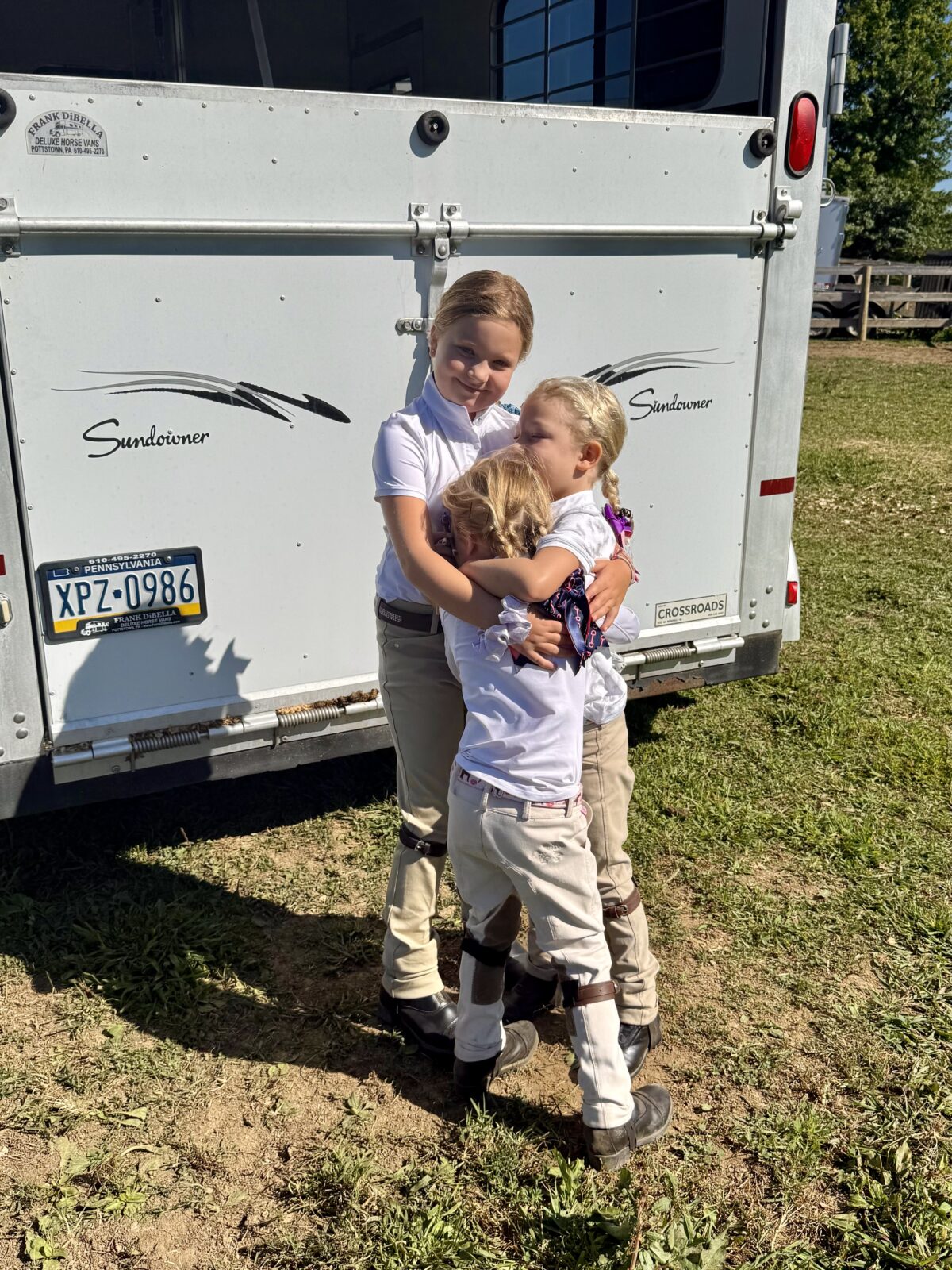
Lately, my heart is heavy watching my oldest daughter’s horse dream unravel. I tried so hard to help her chase it, only to pull her out of a toxic barn. I thought at least we had finally found her a horse while she was there, one that would take her where she’s always wanted to go.
But the truth didn’t match the sales pitch. Now, we’re left with a sweet horse who was misrepresented. And not for the first time, I felt like I failed my daughter. In trying to make her dreams happen, I trusted the wrong people. Again.
I’ve watched my kid hang her head, swallow her tears, and ask if it’s all going to be okay with her horse. And I’ve had to tell her the hardest truth: “I’m not sure.”
I’ve also told her that first and foremost, we must do right by her horse—especially because someone else didn’t. That’s the part no one tells you about chasing dreams with horses; sometimes doing the right thing hurts the most.
She replied softly, “I’m thinking I should just give up riding. It feels like things just keep going wrong — like the bad people always win.” And part of me feels the same. But another piece of me, the part that’s still intact, couldn’t bear to let her believe that.
I told her, “I’m going to find a way for you. We’ll get you back in the show ring.” Even though I don’t know how or when.
But what I do know is that there’s no manual for comforting your child when someone else’s actions have broken both of your hearts. All you can do is keep forging ahead. Teach her the right way.
Keep your integrity. Do what you love. Put the horses first.
And though I’m still fighting the urge to ditch the horses, here’s where I land every single time: we can’t quit. Quitting would teach my daughters that unethical people win. And the horses lose. That we should hand over the joy we’ve built because others made it ugly.
I won’t do that.
Instead, I’ll find a way to make this work—for them and for me. I’ll fight to keep the good parts alive: the giggling in the barn aisle, the horses grazing against the backdrop of changing leaves, the trust in our pony’s eyes. And I’ll make sure, most importantly, to surround myself and my girls with the right people.
Because even in the hardest moments, I’ve learned the good horse people—the truly good ones—show up for me and my girls.
They rally. Offer advice, encouragement, perspective. They remind me that honesty, kindness, and horsemanship still exist. That there’s more good than bad if you look for it. That there are professionals who aren’t out to milk you for everything you’re worth. Who care. Who heal.
So no, I’m not quitting. Not for the shady ones. Not for the heartbreak.
Because as broken as it feels sometimes, this is still where our hearts are. And if there are honest people trying to do it right—parents, kids, horse lovers, and a circle of pros who care—it’s still worth fighting for.
The post When the Horse World Breaks Your Heart appeared first on Horse Network.
The Merits of Efficient Horses and More, Horse Bytes Talks World Cup with Karl Cook 3 Nov 2025, 11:59 pm
Buckle up. This whole episode is one hot take after another.
Paris 2024 team silver medalist Karl Cook joins Olympian Dani Waldman and superfan Sadhbh P (pronounced: SIGH-ve) this week on Horse Bytes, the Podcast, to talk all things World Cup.
Which “star” horses don’t get Dani started? Karl has the horsepower to make a serious bid at World Cup Finals—does he have the desire? What does it really feel like to climb your way up the ranks on the U.S. team?
Listen in to find out!
Tune in every Monday for new show jumping insights, hot takes and more from Horse Bytes, the Podcast, hosted by Dani Waldman and Sadhbh P.
The post The Merits of Efficient Horses and More, Horse Bytes Talks World Cup with Karl Cook appeared first on Horse Network.
Jana Wargers Knows What She Has in Dorette OLD 3 Nov 2025, 10:30 am
Angelica Augustsson Zanotelli may have a crystal ball at home. When the Swedish Grand Prix rider stopped by the GCTV studio to give her pick for the winner of the 11-horse jump-off in the LGCT Grand Prix of Riyadh on November 1—Halloween weekend, appropriately enough—Madame Augustsson Zanotelli had just one combination in mind.
Despite a speedy startlist that included the likes of Simon Delestre (FRA), Gilles Thomas (BEL), and Harrie Smolders (NED), the Swedish rider gave her vote to 33-year-old Jana Wargers of Germany and Dorette OLD.
As it turned out, Augustsson Zanotelli was spot-on: Wargers and the 16-year-old Oldenburg mare didn’t just win the class, they left the rest of the field in their wake, dashing through the timers two full seconds ahead of the rest of the pack.
“I had the feeling my mare was really on it,” Wargers said of the penultimate, curving jump-off line back to a tall and delicate GC vertical, which required riders to come in on just the right angle.
“[By that point], I also had the feeling that I didn’t have that much control left,” Wargers explained, smiling. “Luckily, I got a good distance, so I had a good shot there, and she just carried me around like she always does. She is so special to me.”
Last to go in the jump-off round, Wargers hit the gas and, with the exception of a single fence, didn’t let up—her brave, chestnut mare answering every question, and then some. “I had the feeling I was on it—I had the feeling I was fast enough—so I took a little bit of a longer way to the second-last vertical just to make sure she got a good jump there,” Wargers explained.
“But I know how fast she is, in general, and I got really good [spots] everywhere, so I was pretty sure if I [kept] on it now, then that would be enough.”
Fast Dorette is, according to Jumpr Stats, where she and Wargers jump clear at 42% in 53 rounds at 1.60m+ but finish in the top 10 52% of the time. Their performance on November 1 secured not only Wargers’ career-first 1.60m 5* Grand Prix victory and the €168,300 purse, but also the coveted, final ticket to the LGCT Super Grand Prix in Prague November 20-23.
For Wargers, there was no question which horse she would select for the occasion. “Dorette is my main horse, and she’s incredible, and in such good shape,” she said. “She’s 16 years old and she feels so, so good, so she will definitely be the choice for Prague.”
Interestingly enough, while their partnership today appears nothing less than seamless, it wasn’t always that way between Wargers and Dorette, who came onto the German rider’s string three years ago. “Having a close relationship with your horse is very important and Dorette is a good example of this,” Wargers told World of Showjumping in early 2024, explaining that when the mare first came to her from Ireland, she was a challenging combination of energetic and sensitive.
“In the beginning, she didn’t trust me. I thought about it a lot; I tried to figure out what I could do to make her happy and get her to trust me. With some horses, you have a better relationship or a closer connection faster, while with others, it takes more time to build that bond.”
The solution? Giving Dorette the time she needed to settle in at horse shows while also tweaking her program at home. “With her, it is a lot about how we manage her; in the summer, she goes out in the field for almost the whole day, which she really enjoys, and I can feel how it helps her relax.”
Even back then, Wargers said, she felt that Dorette had the ability to compete at the very highest level of the sport. After Saturday’s performance, the showjumping world at large undoubtedly believes it too.
The post Jana Wargers Knows What She Has in Dorette OLD appeared first on Horse Network.
When the Stars Align: Eerily Accurate* Horse Horoscopes 3 Nov 2025, 8:00 am
Does your horse’s zodiac sign offer a window into his true, planetary personality? Can his cosmic energy help to determine his ideal discipline? Will his celestial sign predict a blue ribbon in 2026?
Well, no. Probably not. But in these uncertain times, turning to the stars for a peek at the year ahead certainly can’t hurt**. Here are our not-at-all-made-up*** horse horoscopes and New Year predictions for 2026—how does your horse match up?
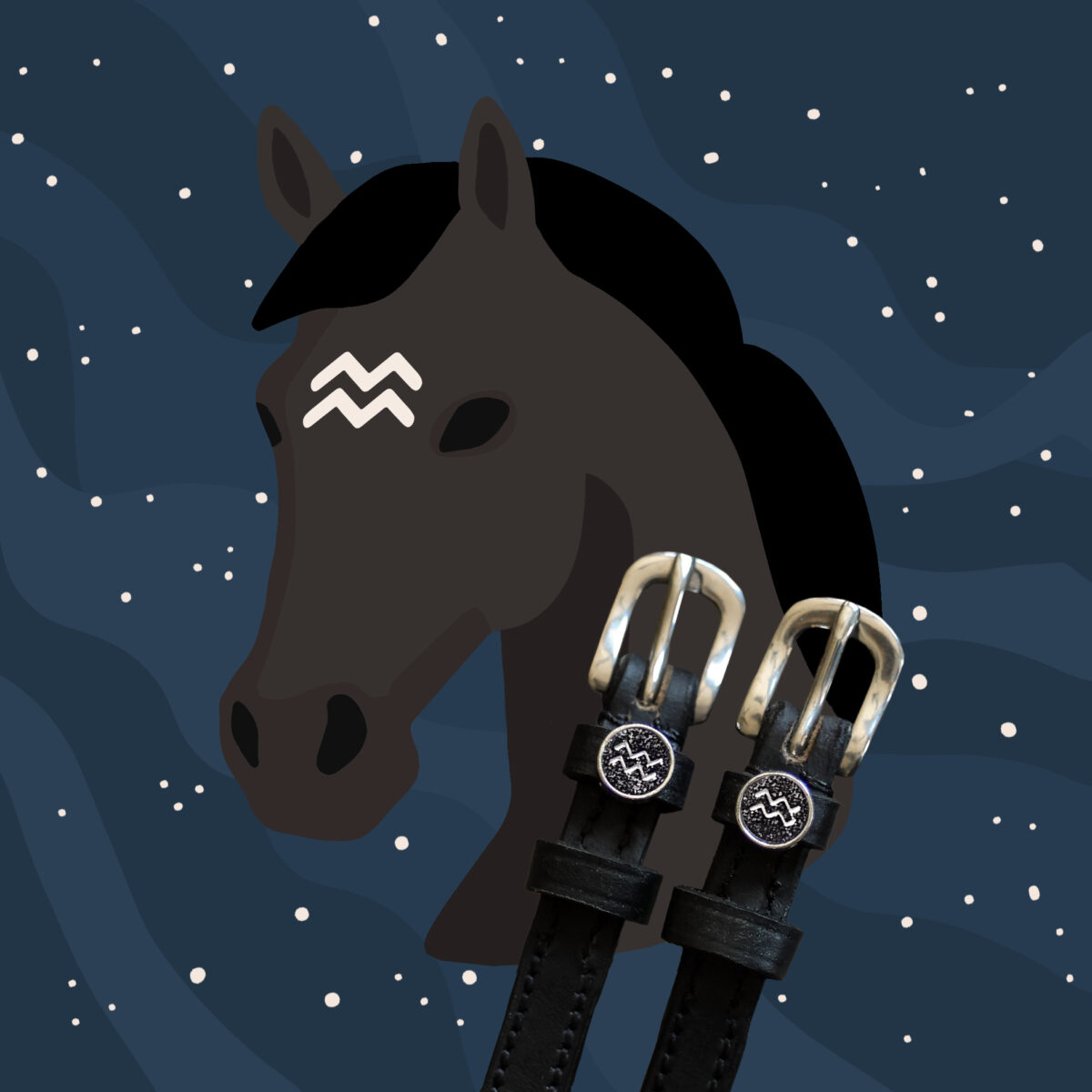
AQUARIUS – The Sea Horse (January 20 to February 18)
A natural leader on trail rides, ‘Sea Horses’ prefer to have one rider who lets them be the boss. These horses may intentionally ignore the aids intentionally; they prefer the tried and true, and don’t like to learn new skills in training. Curious and free-spirited, ‘Sea Horses’ excel at liberty work. They enjoy spending time with their people, but may not get along with new horses.
2026 Horoscope: 2026 may come with a windfall for ‘Sea Horse’ owners, whose earnings will increase substantially in the early part of the year as Jupiter aspects your horse’s House of Gains. You may take home a big paycheck from the classic (yay!) but take care not to spend it all in one place (i.e. the rest of your show bill). Rahu’s influence may make you more ambitious but wise decision making will support steady progress.
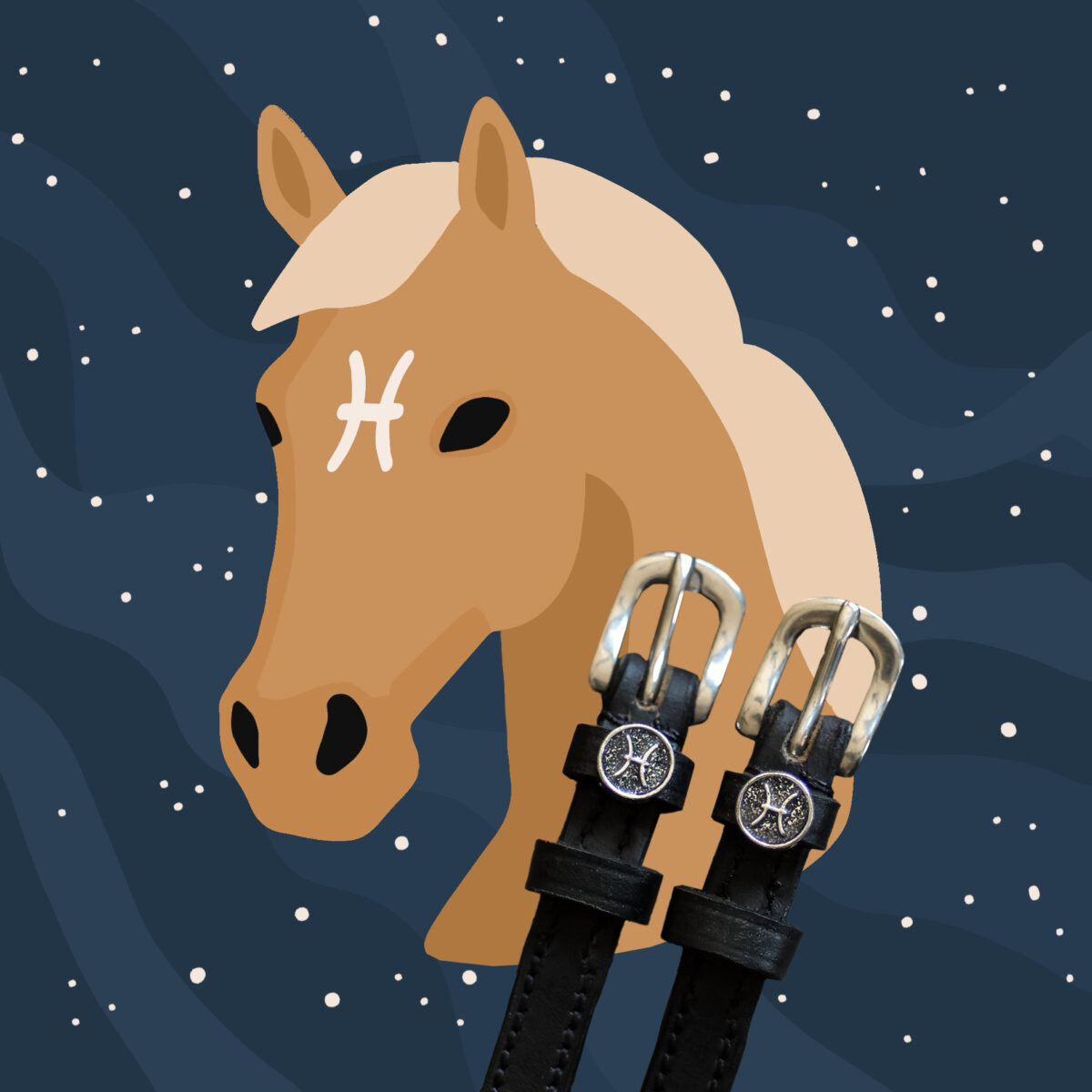
PISCES – The Keeper (February 19 to March 20)
Deeply in-tune to their riders under saddle, ‘Keepers’ may get distracted and “talk back” on the longe line. They can also be hard keepers in the barn, especially as they age. Loyal to their owners, ‘Keepers’ tend to be heart-horses due to their affectionate and goofy personalities, though they can be prone to bouts of spookiness.
2026 Horoscope: With Saturn in your horse’s first house, his or her fears may rise to the surface this year, with every shadow, blowing leaf, or cooler on a jump standard causing reason for alarm. Slow down and work on the basics to build your horse’s confidence; hard work and patience this year will take you both far.
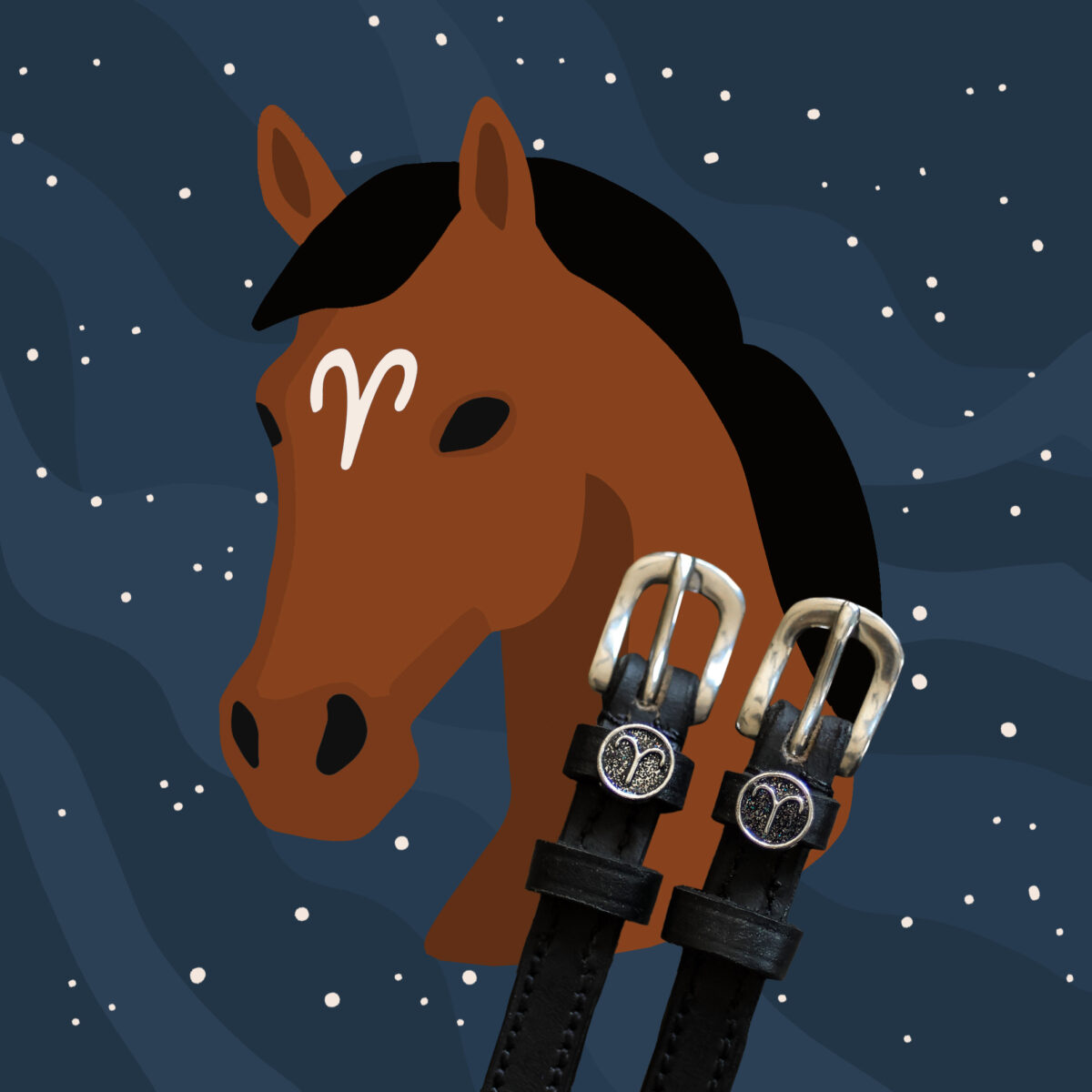
ARIES – The Firebrand (March 21 to April 19)
Dynamic and easy to fall in love with, ‘Firebrands’ enjoy demanding training programs and helping their owners succeed in whatever they do. Generous and giving under saddle, they thrive in exciting, fast-paced disciplines (think: barrel racing and eventing). ‘Firebrands’ can be overreactive and always need to be right: If you pick a fight with one, be prepared to battle for hours.
2026 Horoscope: This year will be one of deep and meaningful growth for ‘Firebrands,’ who may meet new milestones in the discipline of their choice, or in their on-the-ground development. Look to build your horse/rider communication this year by providing your ‘Firebrand’ with new and interesting challenges and experiences (think: gymkhana, beach rides, etc.).
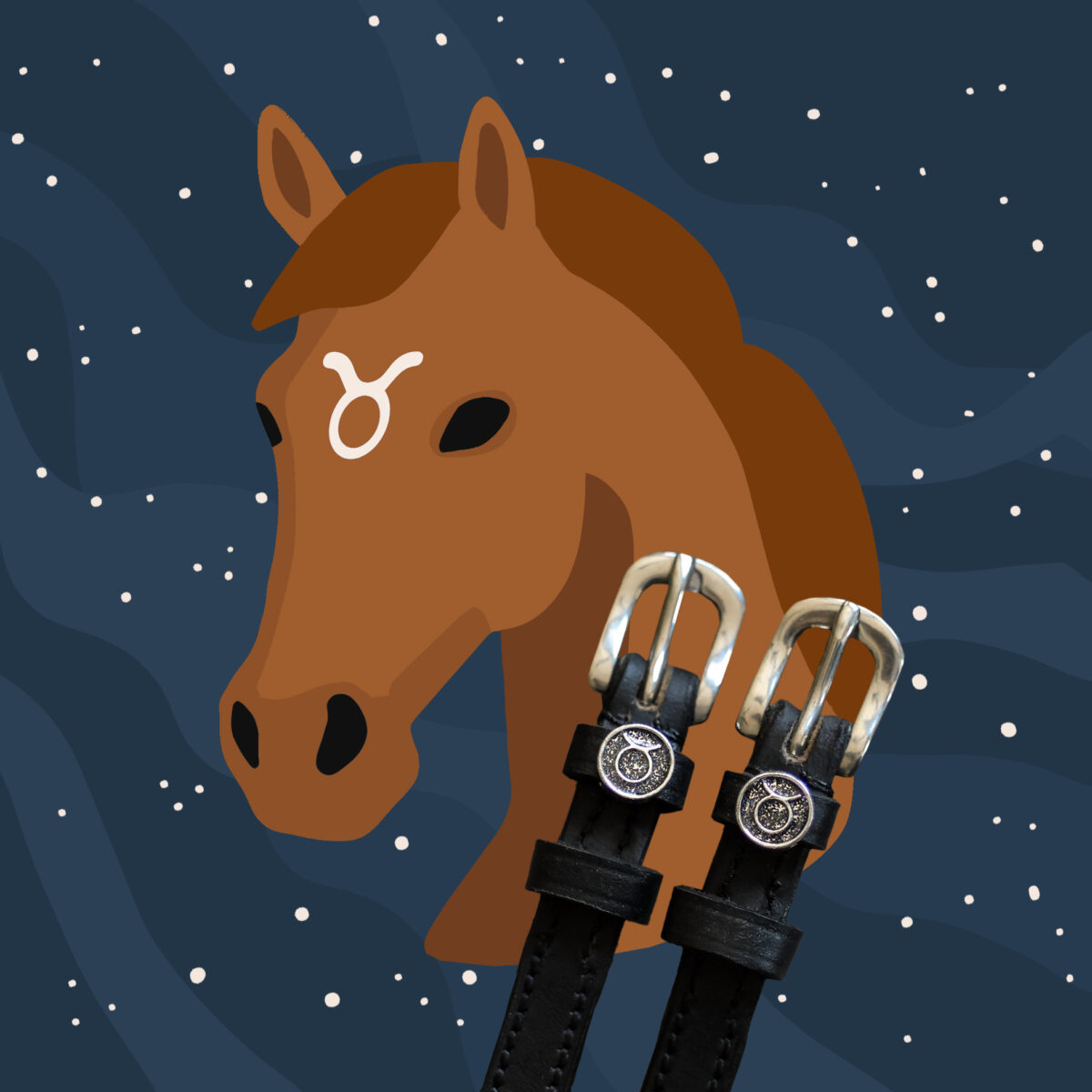
TAURUS – The Royal (April 20 to May 20)
Generally attractive, these horses enjoy being groomed and fussed over. ‘Royals’ like treats and attention, and will often go the extra mile for their riders when the pressure is on. They have a reputation for being stubborn, but are dependable in lesson programs because they come out the same way every day. If ‘Royals’ want something, however—be it grain, turnout, or to leave the ring on a whim—they may make poor choices to get it.
2026 Horoscope: This year, a five-planet conjunction in Aquarius will reactivate ‘the Royals’ 10th house, raising their public image at horse shows and/or social media, or potentially enhancing their rider’s financial position in the first half of the year. While there is potential stress involving horse-and-rider-communication at year’s end, fear not: things will resolve quickly, restoring peace to your barn.
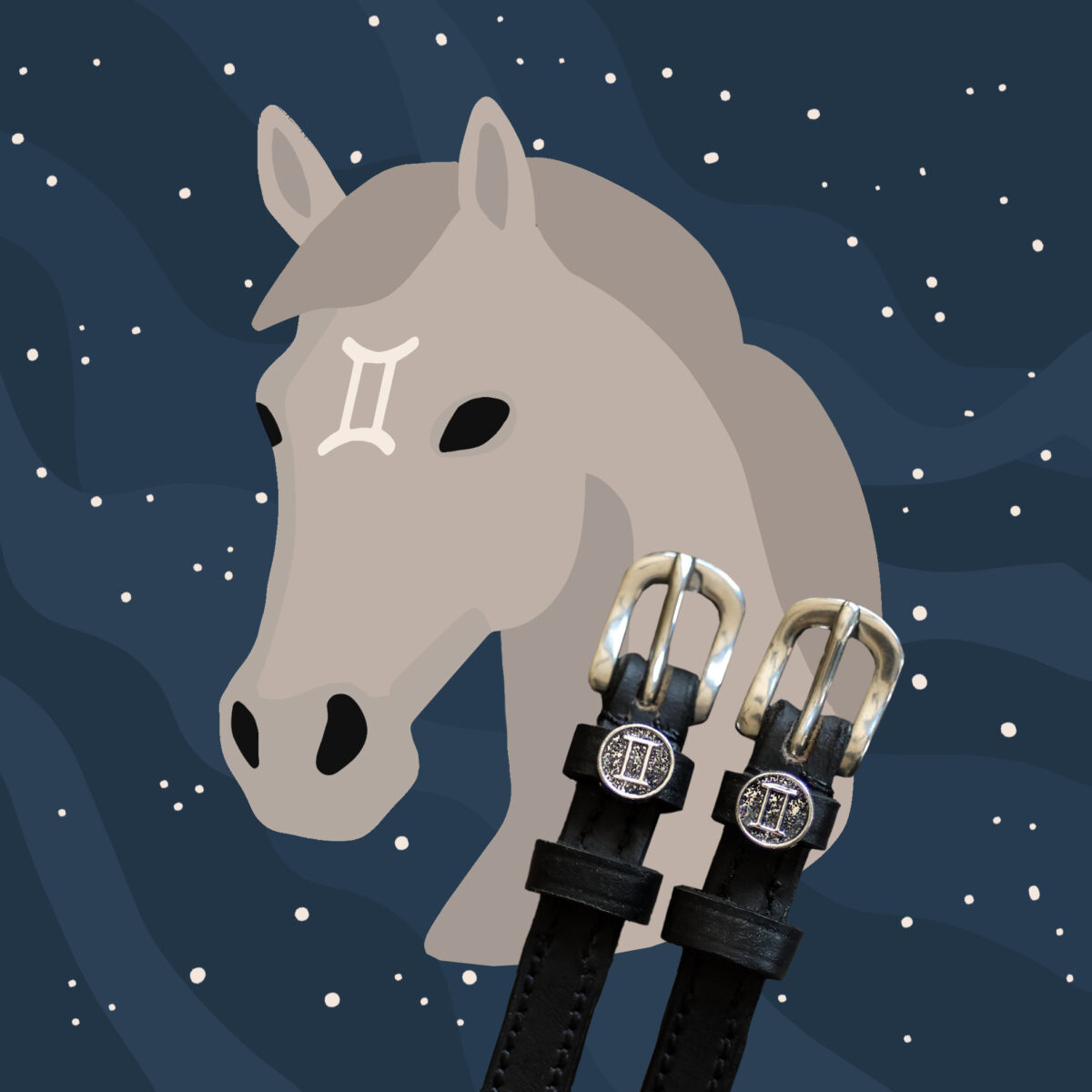
GEMINI – The Twin (May 21 to June 20)
Sweet and good at listening, these horses love to be patted and talked to. Usually well-behaved, ‘Twins’ are equally capable of pulling a quick stop, buck, or spook every now and again for no apparent reason. Easily offended but very forgiving, Twins can be confusing to their riders and require patience, especially when learning new things. In the stable, they can be mouthy and take a long time to grow up. They don’t mind multiple riders.
2026 Horoscope: Whether moving into Novice or up a level in the jumper divisions, expect an increase in your ‘Twin’s’ job responsibilities in 2026. With the Aquarius conjunction forming in their 9th house, there may be the opportunity to travel to new venues with your horse for competition or leisure purposes. Challenges in your training may creep in by year’s end, but overcoming them will make your relationship with ‘The Twin’ stronger and more versatile.
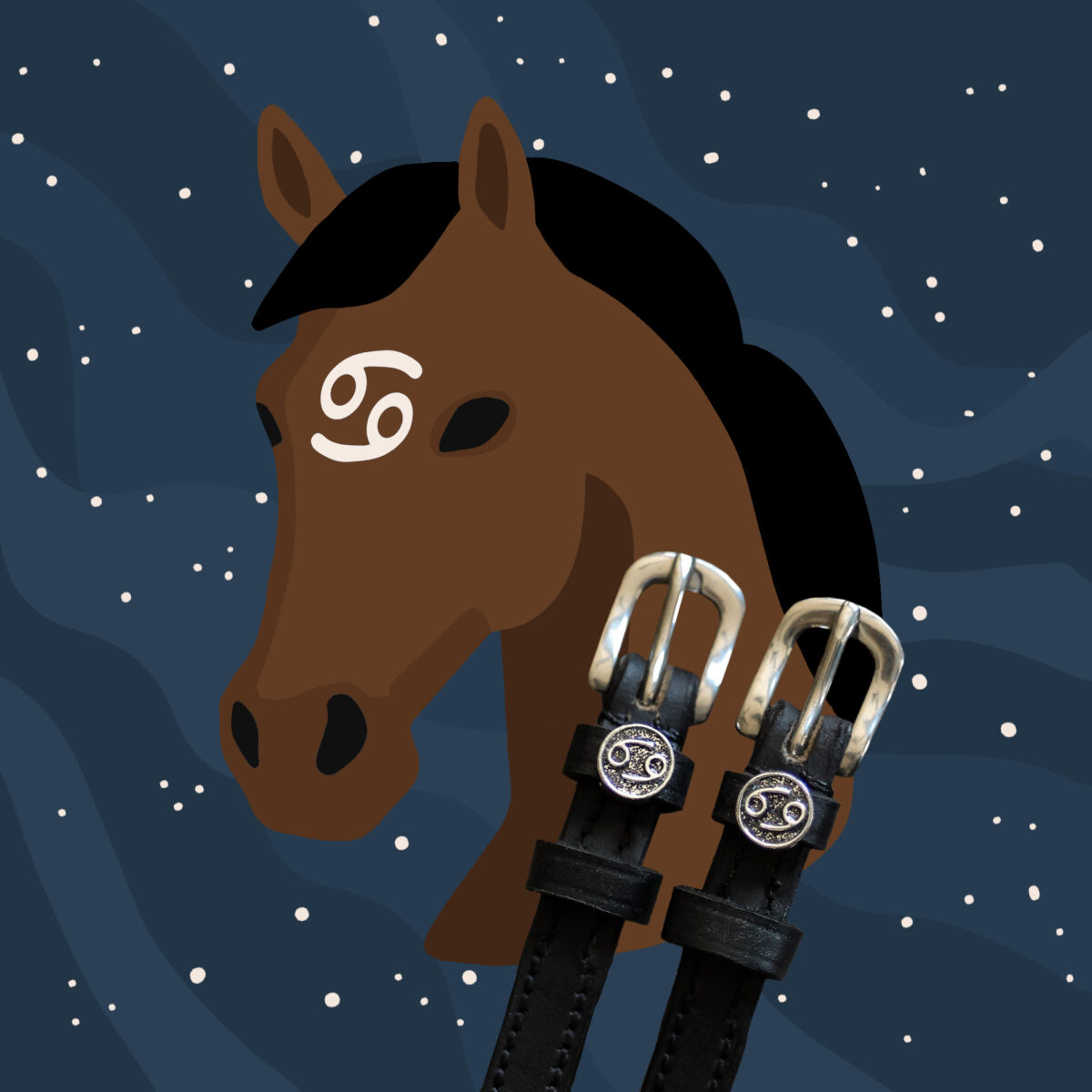
CANCER – The Nurturer (June 21 to July 22)
These kind horses are great with children and excel as schoolmasters. ‘Nurturers’ love to stay at home and form strong bonds with their owner and paddock-mates. Affectionate and sweet, they like to think outside the box, and can occasionally get into trouble as a result. ‘Nurturers’ prefer not to argue during rides, but may throw out a spin or big buck if pressed.
2026 Horoscope: As a year for wisdom-gaining and transformation in ‘Nurturers,’ expect big things to happen stemming from your horse’s growing confidence and training gains in June of 2026 as Jupiter moves into their first house. Sudden events such as lost shoes or cancelled competition dates may occur later in later months, causing shakeups—but all will resolve in due course.

LEO – The Lion-Hearted (July 23 to August 22)
Confident, game, and fun to ride, ‘Lion-Hearted’ horses love attention and bask in the limelight of prize-giving ceremonies. (Don’t even get them started on victory gallops). They are inherently brave, making them natural leaders, but also have laid-back temperaments that are easy to get along with. Preferring to have the same rider for many years, ‘Lions’ can occasionally be grouchy and temperamental.
2026 Horoscope: Expect some inner conflict from your ‘Lion-Hearted’ equine this year, which may result in subtle personality changes due to the presence of Ketu in their moon sign all year long. A new partnership—perhaps an in-barn lease or additional rider—may be on their horizon in March. Whether or not it this is a lasting relationship, however, remains to be seen.
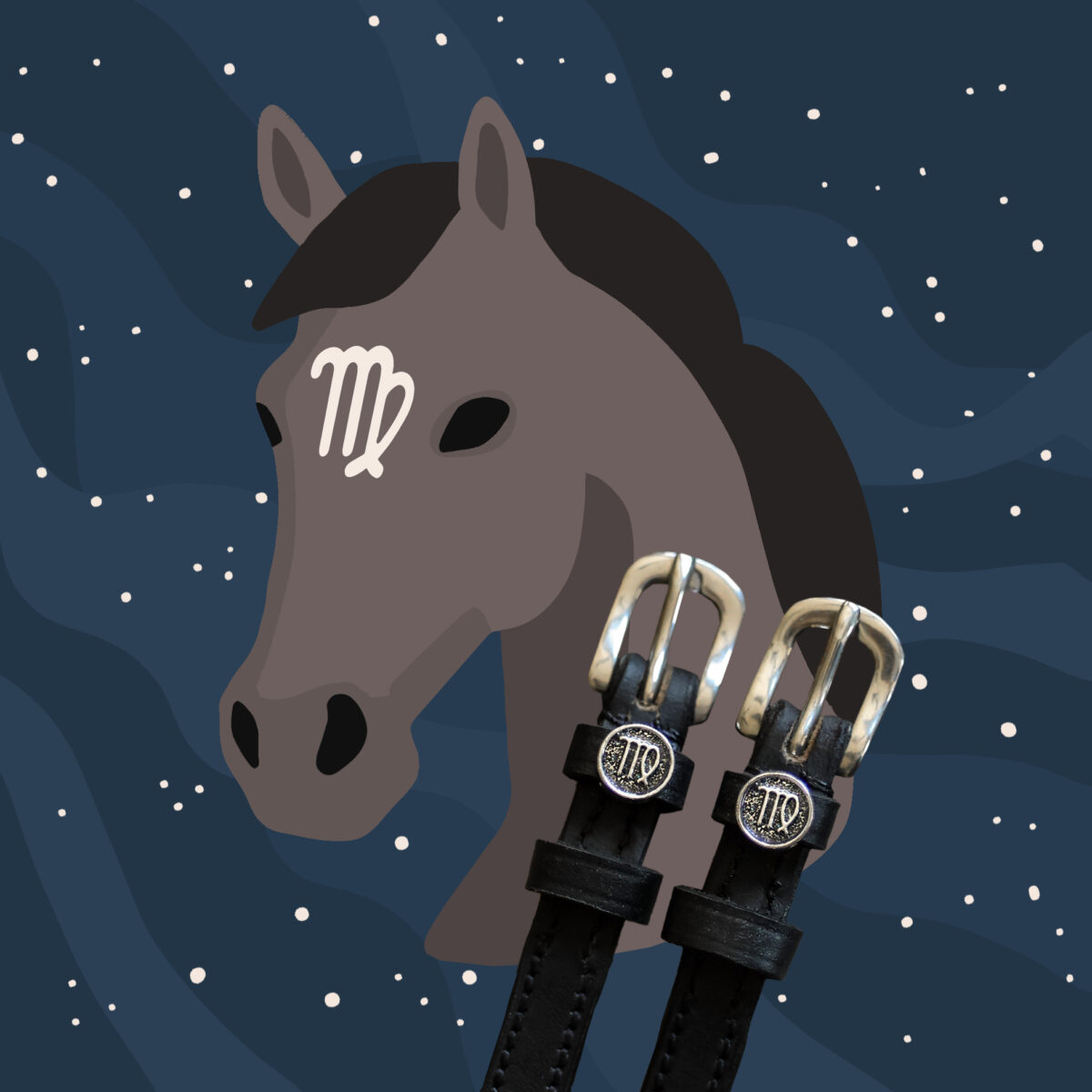
VIRGO – The Precise Pony (August 23 to September 22)
Discerning and intelligent, ‘Precise Ponies’ like to be in charge of every situation. Lovable and loyal, they always want the last word—especially under saddle—but are easy to ride and keep happy, as long as you do it their way. Dedicated and methodical, they excel as equitation, western dressage, or eventing horses. ‘Precise Ponies’ may think they know more than their riders (and many do).
2026 Horoscope: Expect your ‘Precise Pony’ to be especially generous in the first half of 2026 as Jupiter occupies their 10th house, creating new opportunities for your partnership in competition. If your relationship feels a little dull later in the season, that’s just Saturn in your horse’s 7th house: look for new exercises, a tack change, or ground work (think: clicker training) to break up the monotony by year’s end.
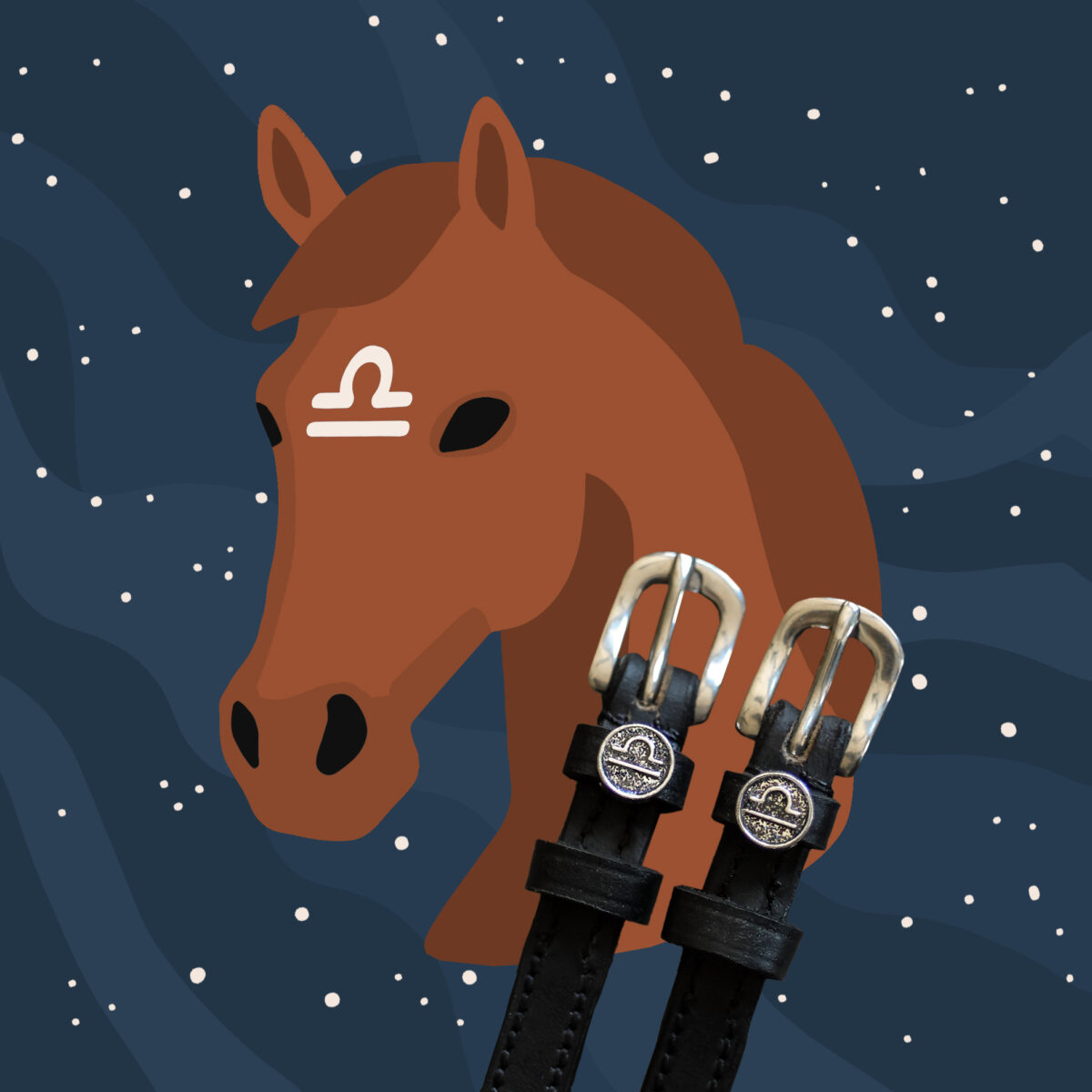
LIBRA – The Team Player (September 23 to October 22)
Kind, silly, and charming, ‘Team Players’ like to be part of a group, whether that’s in the paddock or with their riders in the ring. Patient with a natural sense of fair play, they make wonderful lesson horses—but aren’t above making a pony camper cry every once and a while, just for kicks. ‘Team Players’ enjoy the finer things (hello, German Horse Muffins!) and easily embrace show horse life.
2026 Horoscope: Expect the coming year to be a bit of a roller-coaster for you and your ‘Team Player,’ with unexpected obstacles, sudden gains, and a few lucky breaks going your way in the show ring. You may discover a new hidden talent in your horse’s repertoire this year, but with Rahu in your 5th house, misunderstandings with your ‘Team Player’ may be more frequent than usual.

SCORPIO – The Solid Citizen (October 23 to November 21)
An all-around useful horse dedicated to doing his or her job well, ‘Solid Citizens’ seem to know what their riders want even before they do. Disciplined in the ring, they are intuitive, intense, and tend to form deep bonds with one rider. ‘Citizens’ enjoy having a job into old age, even at the expense of their health. They can be secretive in their stall habits, so pay attention—they may take years to truly get to know.
2026 Horoscope: If you’ve been considering a big transition with your ‘Solid Citizen’—maybe a new boarding barn, partial-lease, or making a trainer or discipline change—2026 may be the astrological time to make the jump. With Jupiter occupying your horse’s 8th house until early June, embrace his or her hidden talents, or consider trying new things together (maybe a hunter pace?) to keep your bond fresh and inspired.

SAGITTARIUS – The Thinker (November 22 to December 21)
An intelligent and enjoyable horse who likes learning new things, ‘Thinkers’ are adaptable, trainable, and diligent to work with—though many have stoic dispositions. They love to be outside and to explore new places and terrains, often excelling in trail, endurance, or eventing. They are occasionally moody, during which times, it’s best to put ‘Thinkers’ away and start fresh another day.
2026 Horoscope: 2026 will be a year of buckling down and working hard for you and your ‘Thinker,’ all of which will pay off in competition results, prize money, or impressing clinicians in the second half of the season. Because of Ketu in your horse’s 9th house, expect a change of plans related to shipping or pre-planned show dates in the coming months.
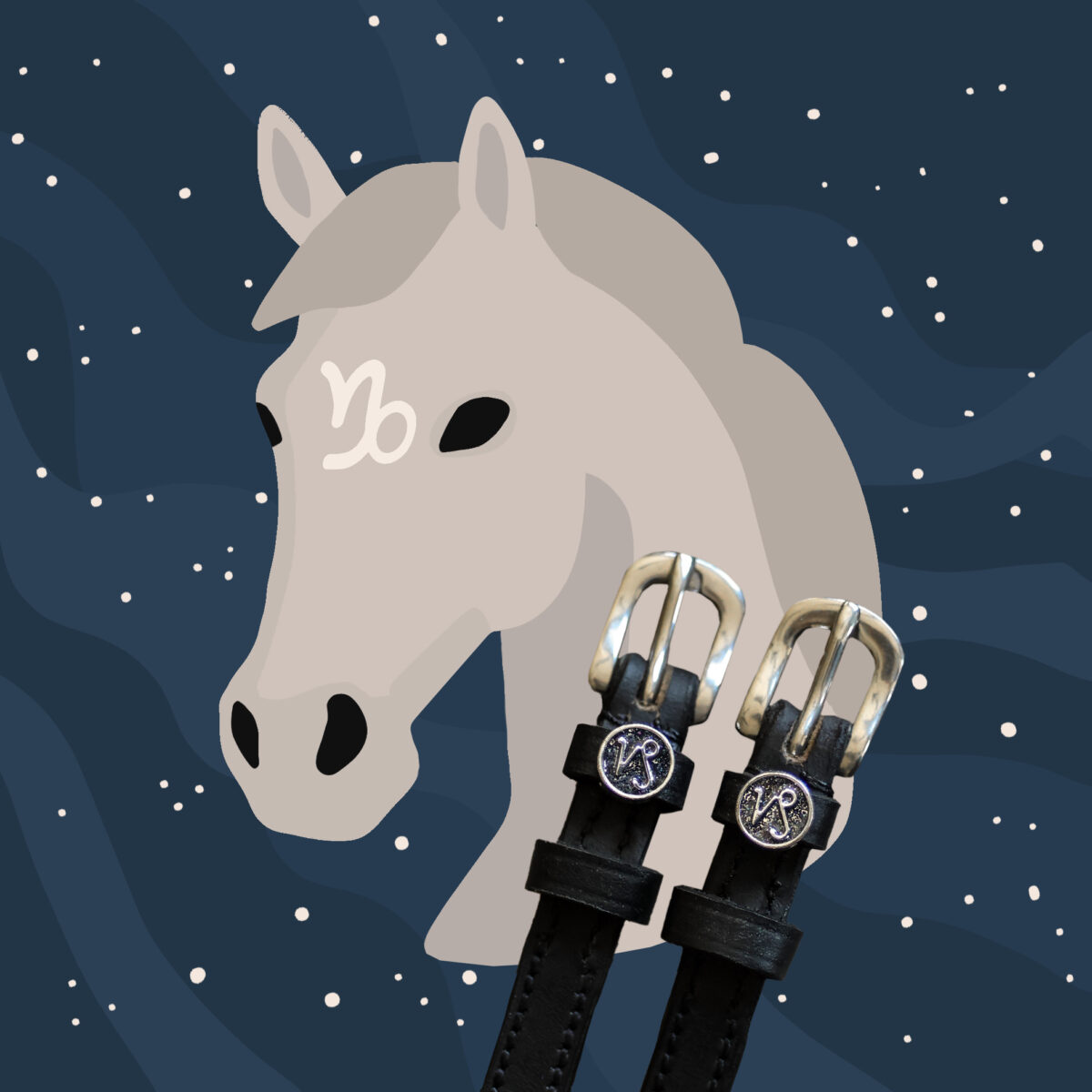
CAPRICORN – The Work Horse (December 22 to January 19)
Capable and determined, these opinionated horses have the talent and dedication to succeed at the highest levels of their discipline. Proud, imperious, and intelligent, these ‘Work Horses’ give their all whether in the show ring or training at home. They know their jobs and do not appreciate those who would try and tell them how to do them differently. Not prone to misbehave, buck, or spook, ‘Work Horses’ are a treasure for any trainer.
2026 Horoscope: A new year of high achievement is on the horizon for you and your ‘Work Horse,’ but watch that you do not overexert yourselves, leading to potential, negative health effects. The Aquarius conjunction may result in unexpected gifts—perhaps a barn mate is cleaning out her tack room? Look for opportunities to travel to places you’ve never been, perhaps a new show circuit or clinic venue, in the first half of the year.
ManeJane limited edition Zodiac Collection Spur Straps are available now. But only while supplies last!
*Time will tell…
**ManeJane is empowered by Three Mares. All profits from the sales of ManeJane go to nonprofits working to make sport safer, more inclusive and more accessible for all athletes. Like you.
***These predications are entirely made up. You can’t fact check celestial bodies.
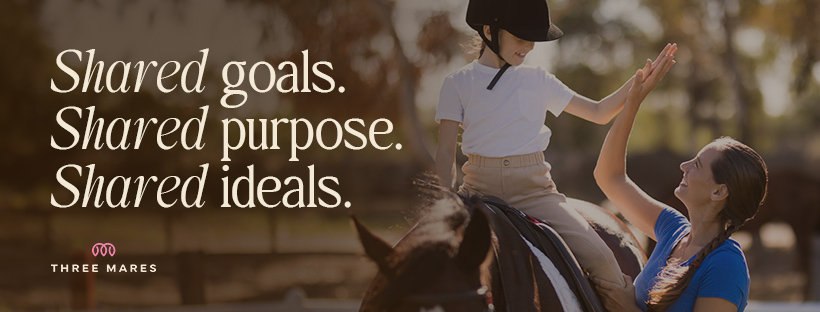
The post When the Stars Align: Eerily Accurate* Horse Horoscopes appeared first on Horse Network.
Olivier Perreau Is a DIY Five-Star Winner 2 Nov 2025, 6:42 pm
Olivier Perreau plays the long game.
The French breeder, 39, solves for a “good mind and good heart” with the 12 foals he produces each year. His homebred mare GL Events Dorai d’Aiguilly possesses both—and then some.
“I always knew she had championship qualify,” Perreau told World of Showjumping in 2024. “I have ridden her since she was four, and every jump she did in her life has been with me. She is a fantastic horse, she is very intelligent, has a slot of scope and when you jump a big class with her, it all feels easy for her. In addition, she is careful… in my opinion she is a crack of a mare.”
Perreau put in the work, too. Produced slowly by the Frenchman, the mare did not compete at young horse finals from ages four to seven in order keep her in good form for her peak career at ages 10 to 16.
That early investment is paying dividends.
In 2023, Dorai d’Aiguilly took Perreau to his senior team debut at the European Championships. One year later, they represented France at the Paris Olympics. On Sunday, they claimed their first five-star title with the Longines FEI Jumping World Cup of Lyon, the second leg of the 2025/2026 Western European League.
Topping an eight-horse jump off and all French podium, Perreau and his homebred Selle Français (Kannan x Toulon) mare bested the ever speedy Julien Epaillard by eight hundredths of a second.
“I’m very happy to finally win the Grand Prix here in Lyon. It was one of my main objectives. I didn’t do the jump-off like I had initially planned but luck was on my side. I tried to give it my best shot by going as fast as I could and staying calm at the end,” said Perreau.
“Winning here with a mare that I bred myself makes the victory even more special. It’s true that breeding horses is still my main job. I won my first 5* Grand Prix with [homebred] GL Events Venizia d’Aiguilly. It’s fantastic, now I’m going to think about trying with my third horse,” he laughed.
“Looking to the future, the World Cup is not an objective for me. After two intense seasons leading up to the Paris 2024 Olympic Games, things have slowed down a bit. I may not have made the best choices in my schedule, but now my horse is back in great form. I’ll try to manage her as best I can.”
The World Cup next heads to Verona (ITA) for leg three on November 9th.
The post Olivier Perreau Is a DIY Five-Star Winner appeared first on Horse Network.
The 2025 LGCT Super Grand Prix Is Belgium vs Germany (Plus Some Other Guys…) 2 Nov 2025, 4:23 pm
The final Golden Ticket for the LGCT Super Grand Prix was claimed in Riyadh on Saturday and it’s shaping up to be a Dutch vs Deutsch showdown.
Jana Wargers of Germany added her name to the startlist, topping the 16th and final Grand Prix of the 2025 LGCT season. Aboard Dorette OLD, she produced a double-clear to stop the clock in 41.71 seconds and become one of just two women to qualify the Super Grand Prix in Prague later this month. Anastasia Nielsen, 19, claimed her spot in Rabat.
“My mare felt really honest today. In that one last line, I made the difference. I just decided to go for it all the way,” said Wargers. “My focus was really on us as a combination. I had complete trust in my mare!
“The thought that I could win the golden ticket might have been in the back of my mind…”
The €1.25 million Super Grand Prix is a win-and-you’re-in format where the top placed rider (not already qualified) in each of the 16 grands prix of the LGCT season earn a ticket. But while the Global Champions Tour hosts riders from across the globe, two nations make up the bulk of the field this year. Of the 16 Super Grand Prix contenders, ten hail from Germany and Belgium.
Riding under the Belgian flag are Olympians Abdel Saïd and Jérôme Guery, 2025 LGCT champion Gilles Thomas, and Philippaerts brothers Nicola and Thibault. The German contingent is made up of 2004 Olympic individual and team bronze medalist Marco Kutscher, 2025 individual Olympic champion Christian Kukuk, plus Gerrit Nieberg, Philipp Weishaupt, and Wargers.
Reigning Olympic team champion Scott Brash (GBR) and championship veterans Harrie Smolders (NED), Simon Delestre (FRA), Maikel van der Vleuten (NED) and Emanuele Camilli (ITL) complete the list.
The LGCT Super Grand Prix will take place Nov 20–23.
The post The 2025 LGCT Super Grand Prix Is Belgium vs Germany (Plus Some Other Guys…) appeared first on Horse Network.
Another Day, Another Championship Title For Gilles Thomas & Ermitage Kalone 31 Oct 2025, 8:24 am
Heavy is the head that wears the crown—and also the Global Champions League (GCL) leader’s armband. Already, at the tender age of 27, though, Belgium’s Gilles Thomas has proven he has what it takes to juggle not only the armband but the GCL’s zero-margin-for-error format—and to do it again, and again, and again.
“We got [the armbands] quite early in the season from the leading team,” said Thomas after he Ermitage Kalone and Hans-Dieter Dreher (GER) with Vestmalle des Cotis clinched the win and the GCL Championship title for Valkenswaard United on Thursday at GCL Riyadh. “It’s been tight all season with the ladies in the Cannes Stars, and today, again, it was quite tight. But we are so pleased that we can win today as well as the overall.”
“Tight” may be an understatement. As the only two teams on the startlist on a score of four after two rounds, it all came down to time, with Valkenswaard United just pipping the Cannes Stars powered by Iron Dames by 0.27 seconds.
It would be that same 0.27 seconds that ultimately gave Valkenswaard an additional 30 points and the Championship title on a final score of 326 to the Stars’ 315. The Shanghai Swans rounded off the podium on 272 points; Riesenbeck International was fourth on 262 points.
“I think what sets us apart and makes the Cannes Stars so special is that our team supports each other so well, the team spirit is something really unique,” said Sophie Hinners (GER), who notched two clear rounds aboard Iron Dames Singclair and Iron Dames Combella. Katrin Eckermann (GER) jumped 4/0 with Iron Dames Dialou Blue PS and Chao Lee, respectively.
“So many people behind us, especially [Iron Dames Owner Deborah Mayor]—before we came to Riyadh for the Final, we already had Deborah telling us how happy and proud she is. So, it’s not that we came with a lot of pressure here—we already were really proud of what we had achieved,” Hinners continued.
Befitting the occasion, Valkenswaard United—who have won the GCL Championship two times previously—arrived in Riyadh with the big guns. Enter: Ermitage Kalone, the 11-year-old Selle Français stallion who Thomas brought in to jump for the first time this season in a GCL Round 1.
And while nothing in show jumping is ever “a lock”, Ermitage Kalone is the next best thing.
In June, the pair won the LGCT Grand Prix of Paris, followed by team gold and individual bronze at the 2025 European Championships. Perhaps most tellingly, they currently jump clear a whopping 68% of the time at 1.60m+, according to Jumpr Stats.
Having already secured two wins in Paris and at LGCT New York (with Qalista Dn), and three podium finishes in LGCT Grands Prix this season, Thomas punched his ticket not only to the LGCT Super Grand Prix, but also earned the LGCT Championship. What’s more, he did it at LGCT Rome, ahead of the last stop in Riyadh, on an uncatchable 275 points.
Now, with both the GCL and LGCT Championships in his pocket, Thomas will look ahead to the Prague Playoffs (November 20-23), where Valkenswaard United, along with the top four 2025 season finishers, will secure a bye into the GCL Super Cup Semi-Finals. Their aim? To secure a hefty share of the €10 million in prize money.
But the question on everyone’s mind, is, could Thomas take both Championship titles and win the GCL Super Cup or the LGCT Super Grand Prix next month—or both? For now, the Belgian rider seems to be keeping his cards close to his chest.
“Here [in Riyadh], we were in very good shape,” Thomas said when asked if he could go on to a possible third or fourth Global Champions title this season. “For sure, the next step is Prague.”
The post Another Day, Another Championship Title For Gilles Thomas & Ermitage Kalone appeared first on Horse Network.
The Tangled Webs They Weave: ADHD, Amphetamines & Anti-Doping 30 Oct 2025, 2:32 pm
This month, Irish Olympic show jumper Darragh Kenny was provisionally suspended by the FEI following the results of human anti-doping testing that occurred at the Longines FEI Jumping European Championships in A Coruña, Spain in July.
The drug in question, according to a statement released by Horse Sport Ireland, involved a substance classified under Class S6 (Stimulants) on the World Anti-Doping Agency (WADA) Prohibited List. “Substances in this category may be found in certain prescribed medications used in the treatment of medical conditions such as attention deficit hyperactivity disorder (ADHD), anaphylaxis, and cold and flu symptoms,” the statement read.
Kenny, who said he is fully cooperating with the FEI and the International Testing Agency (ITA), explained that the medication is part of a prescribed treatment for ADHD that he was taking under medical supervision.
“I want to emphasize that I never intended to gain any competitive advantage. My sole aim was to responsibly address a medical condition under professional guidance,” Kenny said. “I am deeply grateful to my National Federation, my sponsors, owners, clients, and the broader equestrian community for their support throughout this process.”
This is not the first time that ADHA medication has been made headlines in the wake of a major championships. After hackers circulated confidential records from WADA showing that five-time Rio Olympic medalist Simone Biles was legally using prescribed Ritalin for ADHD while competing, she went public about her condition in a series of tweets.
“Having ADHD, and taking medicine for it is nothing to be ashamed of nothing that I’m afraid to let people know,” she wrote.
American swimmer Michael Phelps, the most decorated Olympic athlete of all time, also struggled with ADHD as a child. It’s a condition that affects an estimated 7 million (11.4%) U.S. children aged 3–17 years, according to the CDC. In his memoir Beneath the Surface, Phelps explained that he took medications for several years but weaned himself off at age 13, feeling that the drugs were a “crutch.”
But concerns about dependency aren’t the only reason that people with ADHD may struggle with prescribed medications, says author, neuroscience professor, and cognitive science PhD, Janet Jones. “People with ADHD don’t take Ritalin or Adderall because they want to. They take it because they have to in order to function properly,” she says.
“The side effects include racing heartbeat, irritability, anxiety, headaches, increased blood pressure, skin rashes, digestive problems, weight loss, tremors, tics, diarrhea or constipation, mood swings, hives, dizziness, and nausea. I mention these to point out that any positive effect of these medications on performance is easily offset by the many problems they cause.”
According to Jones, the most common prescribed stimulants used to treat ADHD—Ritalin and Adderall—work by helping patients increase their focus and reduce impulsive or hyperactive behavior by increasing dopamine and norepinephrine in the brain.
“The medications do not cure ADHD; they reduce its symptoms—just as medications do for hundreds of other diagnosed disorders and diseases,” Jones says.
“People who have been diagnosed with ADHD often experience lack of focus, trouble finishing tasks, feeling overwhelmed by multiple tasks, poor time management, and difficulty prioritizing multiple tasks. They tend to be impulsive, making decisions that are not well considered, and they tend to be hyperactive.”
The result, Jones explains, often makes basic, daily activities that most of us take for granted (think: organizing our lives, keeping appointments, completing large projects) difficult for those who suffer from ADHD. “Often they are restless, try to do too many tasks at once, or carry out risky or impulsive behavior,” Jones explains, adding that about 70% of adults with ADHD suffer from insomnia as well.
While ADHD medications containing methylphenidate and amphetamine derivatives are currently prohibited by WADA—whose international standards the FEI follows, using the International Testing Agency (ITA) to administer them—Darragh Kenny would have had the ability to apply for a Therapeutic Use Exemption (TUE) prior to competing at the European Championships.
Obtaining a TUE requires the completion of an application form and checklist, with a medical report submitted by the athlete’s treating physician or clinical psychologist, along with supporting documentation. Over the last three years, according to statistics, the FEI, via the ITA, has either approved or closed/withdrawn approximately 89% of the TUE applications it’s received, with a handful of results still marked as “pending”.
It should also be noted that, according to WADA Physician Guidelines for ADHD, it is not recommended that athletes with the condition stop established treatment protocols, medications included, during competition periods. “It is now generally considered that cessation of treatment can have a number of negative effects including an adverse effect on symptom control, which can take time to re-establish,” the guidelines explain.
“This destabilizing of symptom control can also lead athletes to have an increase in risk-taking behaviors and can potentially increase their involvement in conflict situations (e.g. altercations with referees).”
What’s more, given that the chronic nature of ADHD and the fact that pharmacological treatment of individuals with the disorder usually takes place over many years, TUE durations may be granted for up to four years at a time for well-documented cases of an ADHD diagnosis on a stable dose medication.
Whatever the reasoning behind Kenny’s failure to disclose or decision not to submit a TUE form in line with the FEI’s protocols for the European Championships—and one can only speculate as to whether or not this omission may have actually been influenced by his ADHD diagnosis—he would not be the only international rider to find himself in hot water for anti-doping violations involving a failure to declare prescribed ADHD medications.
In May of 2018, three American eventing riders—Jennie Brannigan, Hannah Burnett, and Alyssa Phillips—failed drug tests that had taken place at the CIC3* Ocala Jockey Club International in November of 2017.
All three tested positive for amphetamine and other ADHD-related drugs and faced a fine, disqualification of their results (included Burnett, who had won the CIC3* with Harbour Pilot), and a one-year suspension from competition. All three, however, also had prescriptions from a doctor for their ADHD medications and received prospective TUEs to use them in future competitions.
Additionally, the FEI considered several mitigating factors while adjudicating their cases, including their inexperience with anti-doping, comprehensive medical documentation for their prospective TUEs—proving that they were not seeking an unfair competition advantage—the prompt admission and explanation for the reason behind their positive tests, and, in one incidence, the declaration of the prohibited substances on the competition’s Doping Control Form.
It is unknown whether Kenny, 37, has previously applied for TUEs for his ADHD medications, or if this is a recent diagnosis and/or part of a new prescribed treatment plan. If so, his ADHD diagnosis in later life would not be unusual. “About half of ADHD patients are diagnosed in adulthood but report having had symptoms since childhood,” Jones explains.
However the FEI Tribunal ultimately comes down on Darragh Kenny’s suspension, Janet Jones believes it is worth reexamining how we view the role of ADHD medications in sport, and on the whole. “If the FEI wishes to consider Ritalin and Adderall as ‘performance-enhancing’ medications in ADHD patients, it’s going to have to take a hard look at other chemical substances as well,” she says.
“Does the FEI wish to prohibit nicotine, aspirin, antihistamines, statins, antidepressants? I don’t think so, but that’s the equivalent of prohibiting Adderall and Ritalin for people who have been diagnosed with ADHD. Is the FEI going to prohibit diabetics from performance on the grounds that insulin helps them achieve mental clarity? Again, I don’t think so.
“My opinion is that if a competing athlete has been diagnosed with ADHD by a medical doctor, they have the right to take prescribed medications to treat it,” Jones continues. “And they should have the right to compete just as anyone else does in the show arena.”
The post The Tangled Webs They Weave: ADHD, Amphetamines & Anti-Doping appeared first on Horse Network.
Leading With Compassion: Erin Ochoa’s Vision and the Future of Equine Welfare 29 Oct 2025, 7:34 pm
For more than three decades, Days End Farm Horse Rescue (DEFHR), in Woodbine, MD, has stood as a beacon of hope for neglected and abused horses, transforming lives through rescue, rehabilitation, and education. Under the leadership of Chief Executive Officer Erin Ochoa, DEFHR has evolved from a respected local rescue center into a nationally recognized authority on equine welfare. Ochoa’s vision extends far beyond crisis intervention; she’s shaping how the entire industry approaches education, prevention, and sustainable animal welfare. As DEFHR embarks on an exciting new chapter with its planned National Equine Welfare Center, Ochoa reflects on her two decades with the organization, the lessons she’s learned, and the legacy she hopes to build.
I came to DEFHR 20 years ago, at a point in my career when I was seeking a place where my leadership skills could intersect with my love of horses. DEFHR’s mission immediately resonated with me—not only its commitment to rescuing horses in crisis through law enforcement partnerships, but also its strong foundation in education and community inclusion. It was clear to me from the beginning that this organization had something special, and I wanted to be part of its growth.
When I accepted the role of CEO, I saw an opportunity to take DEFHR from a locally respected rescue to a nationally recognized market leader. Over time, my vision has evolved from focusing primarily on rescue and rehabilitation to positioning DEFHR as a hub for equine welfare education, advocacy, and even tourism. Today, we’re not just caring for horses—we’re helping shape how the entire industry thinks about equine welfare.
I’m proud of the horses we’ve saved, the staff I’ve mentored, the $6m capital campaign that’s now more than halfway funded toward facility improvements and the foundation of our planned National Equine Welfare Center.
But my proudest achievement is seeing DEFHR become a trusted national partner to law enforcement and equine professionals. We’ve earned a seat at the table in shaping the future of animal welfare, and that’s something I’m incredibly excited to see unfold.
There’s really no “typical” day at DEFHR. It might start with feeding and medical care for our horses, then move to training sessions, volunteer coordination, or consultations with law enforcement. In the office, we’re just as busy: fundraising, managing programs, working on strategic initiatives, and connecting with our donors. The variety keeps every day dynamic and rewarding.
Humbling Resilience
One common misconception about rescue horses is that they are somehow damaged or untrusting. In truth, many go on to become extraordinary companions, show partners, and therapy horses.
Horses have an incredible capacity to forgive and to learn. They often rediscover trust despite being prey animals whose natural instinct is caution. Their resilience is both humbling and inspiring, and they shouldn’t be defined by the circumstances in which they were placed.
Another misconception is that horse ownership is simple. In reality, it’s a serious, long-term responsibility.
Horses are expensive to care for, can live well into their 30s, and have complex physical, emotional, and husbandry needs. At DEFHR, we help ensure that adopters understand this commitment and partner with them for the lifetime of their horse, serving as a forever resource and support system.
We evaluate success not just by how many horses we rescue, but by the depth of transformation we create—horses restored to health, volunteers trained and inspired, officers better equipped to handle cruelty cases, and communities educated about responsible ownership.
Success also means sustainability: the ability to keep doing this work at a high standard for years to come.
My leadership style is vision-driven within a culture of accountability, shared ownership, and passion for excellence. In the short term, my focus is on completing our capital campaign and the corresponding facility improvements that will support expanded programs and impact.
Long-term, I want the National Equine Welfare Center to become an international destination for education, training, and innovation—a place where knowledge, compassion, and sustainability intersect to shape the future of horse care and protection.
Sustainability is, in fact, our biggest challenge—balancing the immediate needs of horses in crisis with the long-term resources required to support them. We rely on donor support, so we’re strategic about diversifying funding streams and using our capital campaign to strengthen infrastructure. Bringing donors along on that journey, helping them see their tangible impact, is essential.
Addressing Neglect at Source
Over time, DEFHR’s approach has evolved from being primarily reactive to becoming a proactive leader in education and prevention. Through training law enforcement, publishing resources, and public engagement, we’re addressing neglect before it starts. Community outreach is central to that—whether we’re hosting school groups, partnering with tourism networks, or showing up at local events, we’re building trust through transparency and inclusion.
We’ve also seen changes in the landscape of equine neglect. Today, many cases stem not from outright cruelty but from overwhelmed owners struggling with rising costs, limited access to land, or personal hardship.
The well-being of horses is directly tied to the well-being of their caretakers. That’s why the future of equine welfare must include systemic support for people, not just horses.
Education is at the heart of everything we do. Every horse we rescue is a life changed, but every person we educate has the power to prevent suffering from ever happening. We collaborate closely with law enforcement, providing expertise, facilities, and evidence collection. We often testify as expert witnesses and act as the voice for the horse, ensuring that compassion and justice go hand in hand. We also use storytelling and immersive experiences to connect people emotionally to our mission, creating lasting empathy and understanding.
Personally, horses have taught me patience, resilience, and presence. They live in the moment, free from resentment or worry. Many have suffered unimaginable neglect, yet they still find a way to trust again. Their forgiveness and strength inspire me every day.
Even on the hardest days, I’m motivated by the transformations I witness—seeing a horse go from emaciated and hopeless to healthy, vibrant, and ready for adoption never loses its impact. I’m equally inspired by our volunteers, whose dedication and love remind me why this work matters.
Ultimately, I envision a future where rescue is less about crisis response and more about prevention, education, and sustainability. I want DEFHR to remain both a frontline rescue and a thought leader in equine welfare. I hope that the organization continues to thrive as a place where people and horses heal together—where education changes perspectives and compassion ripples outward into the community.
My legacy, I hope, will be an organization that’s financially strong, nationally influential, and rooted in empathy; an enduring force for good that transforms both horses’ and people’s lives for generations to come.
Learn more about Days End Farm Horse Rescue and horses currently available for adoption, here.
The post Leading With Compassion: Erin Ochoa’s Vision and the Future of Equine Welfare appeared first on Horse Network.
Laura Kraut Is Very Well, Indeed 27 Oct 2025, 12:29 pm
When a jump off features eight proven five-star winners, five of them Olympians, you need a little luck on your side—and/or your horse to sprout wings.
Laura Kraut and 10-year-old Zangersheide gelding Tres Bien Z (Toulon x Nabab de Reve) did just that in the first North American League qualifier of the World Cup season on Saturday.
The first pair to go double clear in the FEI Jumping World Cup Washington CSI5*-W, they set the time to beat at 40.83 seconds with a daring track and calculated risk.
“I didn’t think that seven strides was possible from fences two to three, but Lillie Keenan did it right before I went, so I thought, ‘I’ll see how I jump fence two and give it a go.’ He grew wings to do that because it was very far away, and I can’t believe he did it,” said Kraut.
“Then, I just went as quick as I could go with him. He’s a handy horse. It was one of the reasons why I thought it would be good to bring him indoors, and he just tries really hard.”
Previously campaigned by Great Britain’s Tim Gredley up to 1.45m, Kraut took over the reins on Tres Bien Z in winter 2024. The pair made their 1.60m debut in January 2025 and have jumped clear and into the top 10 in four of their six starts at the height.
Saturday’s World Cup marks their first Grand Prix win and Kraut’s ninth 1.60m+ podium finish this year.
At 59, the world no. 8 is having one of her best seasons in recent history. She’s earned $1.5 million USD in prize money to date in 2025, nearly as much as her three prior seasons combined.
Tres bien, Laura Kraut. Tres bien.
The post Laura Kraut Is Very Well, Indeed appeared first on Horse Network.